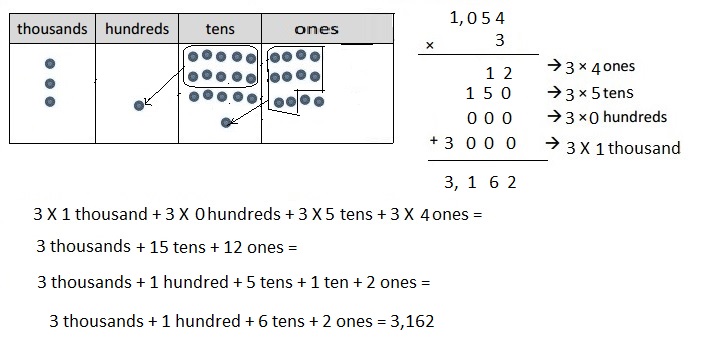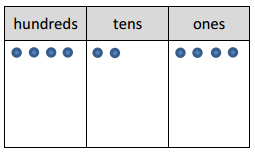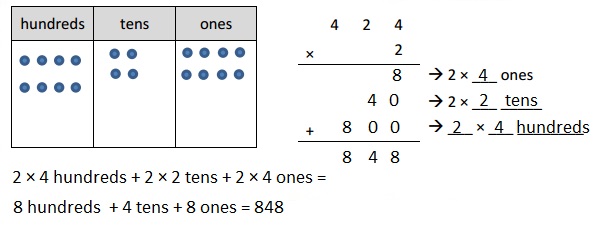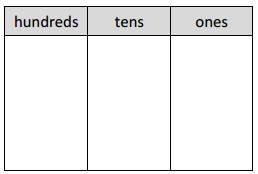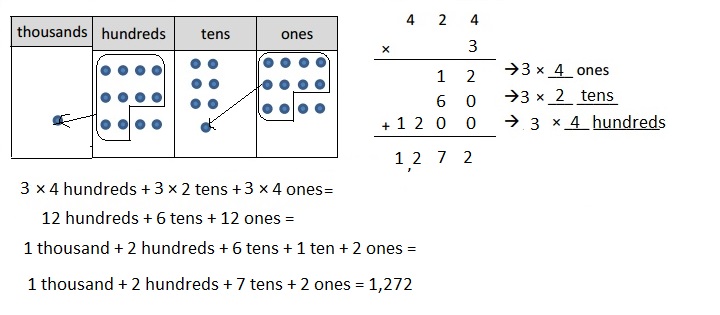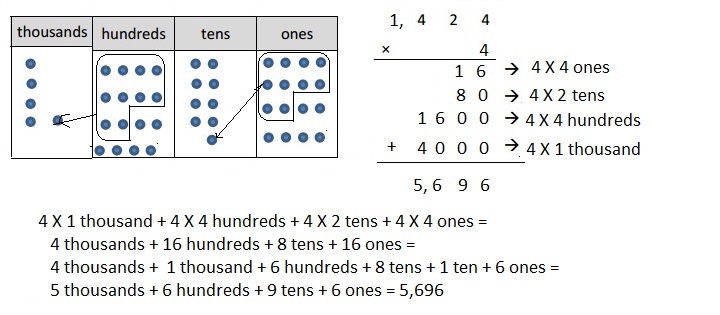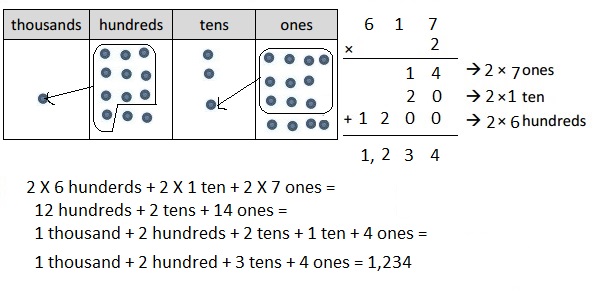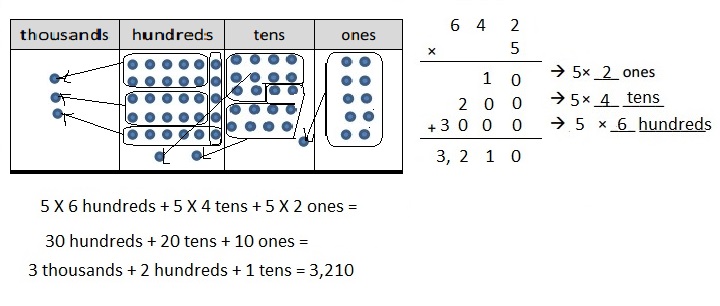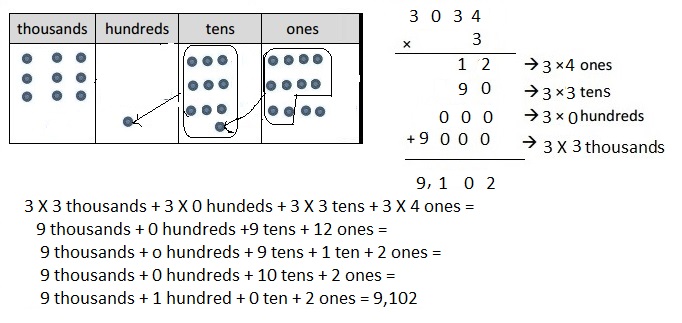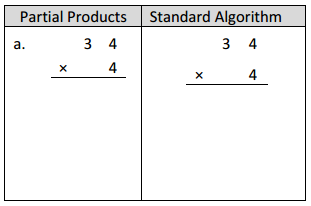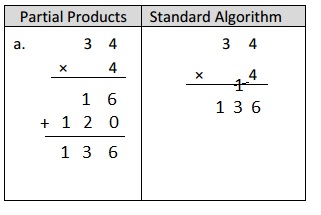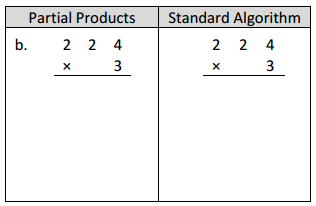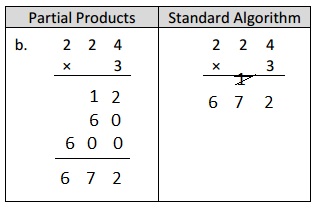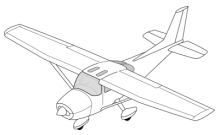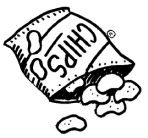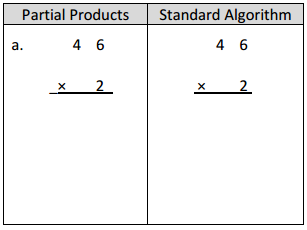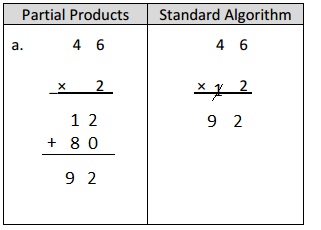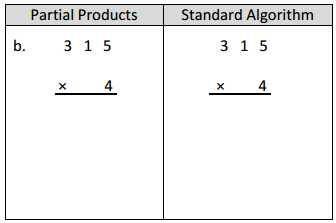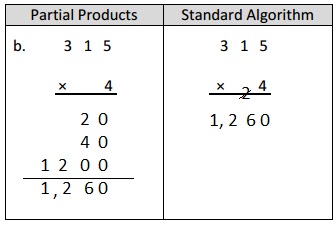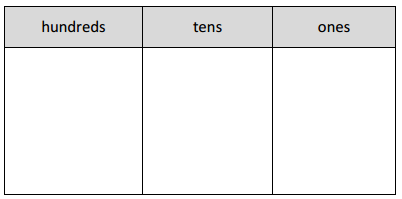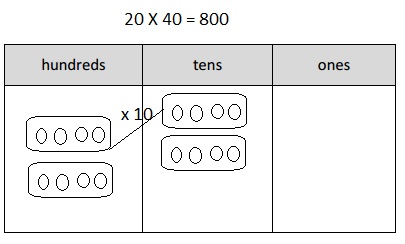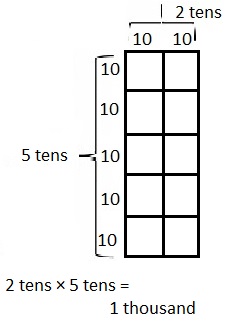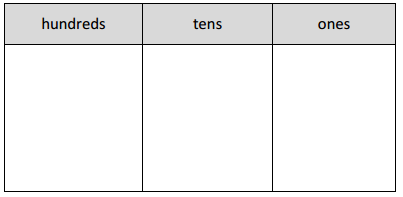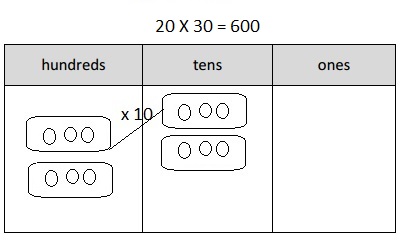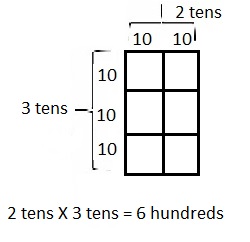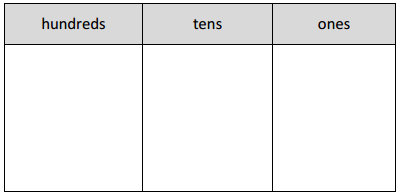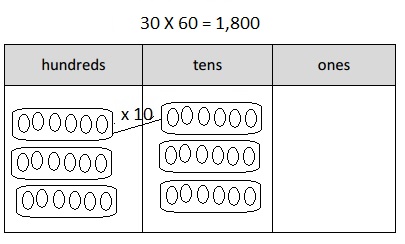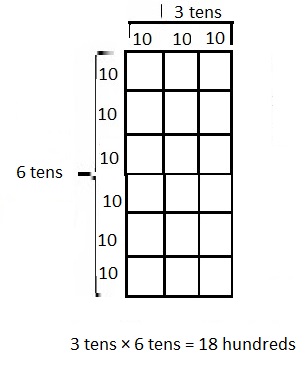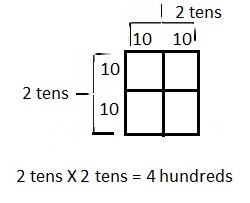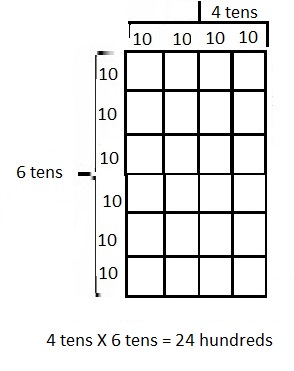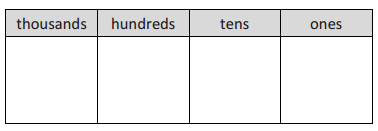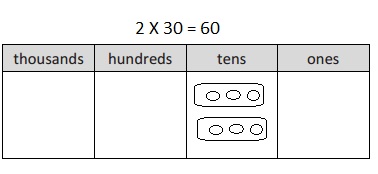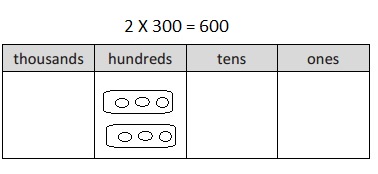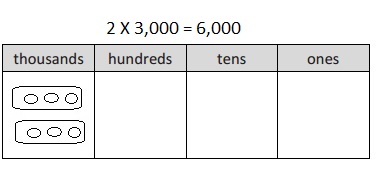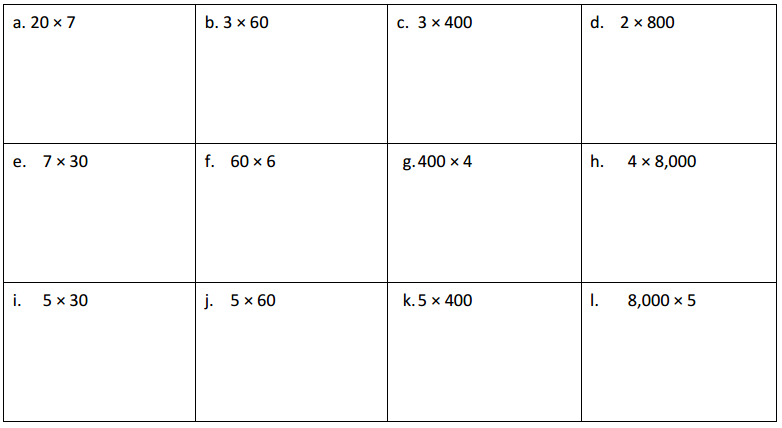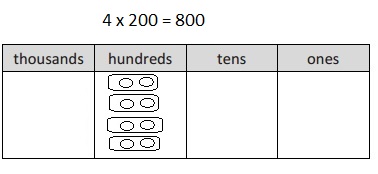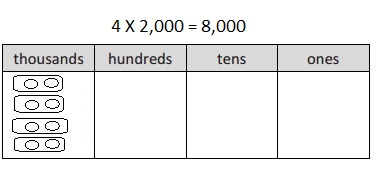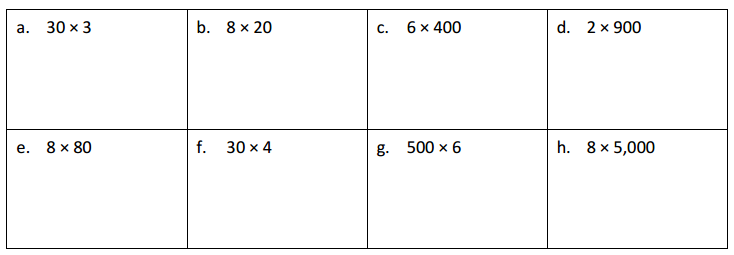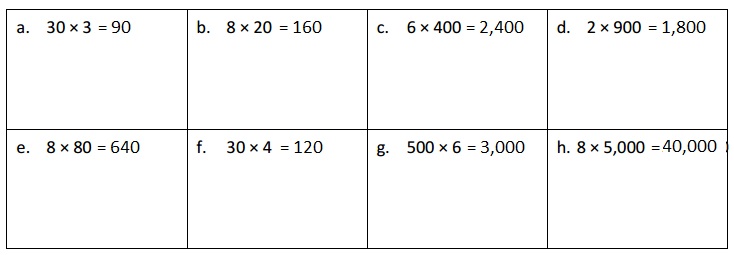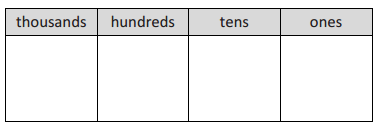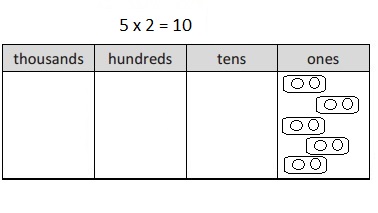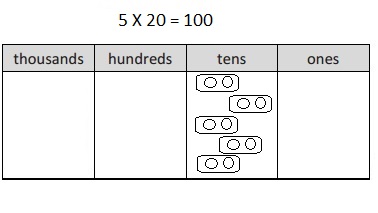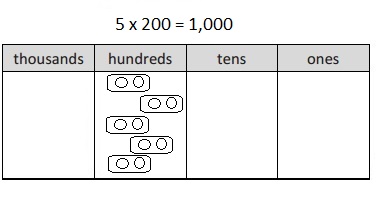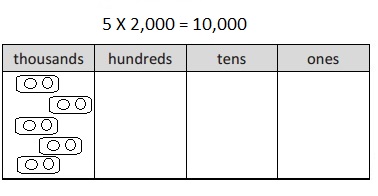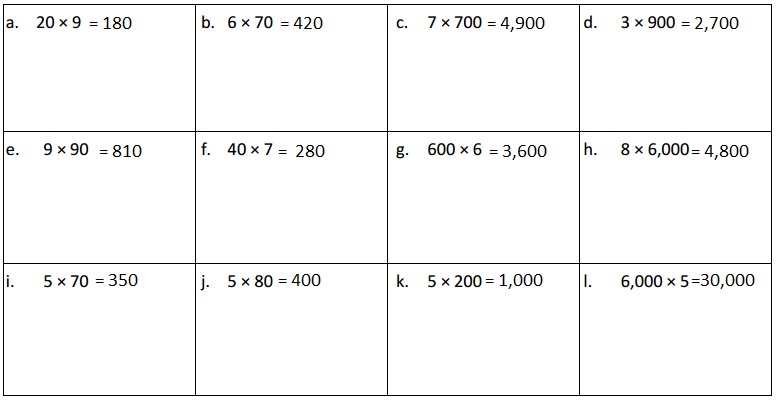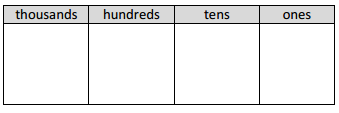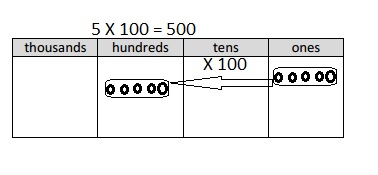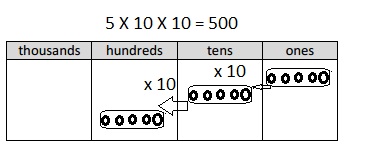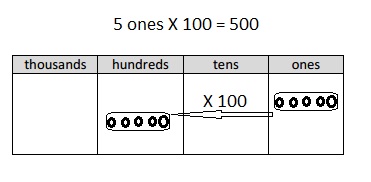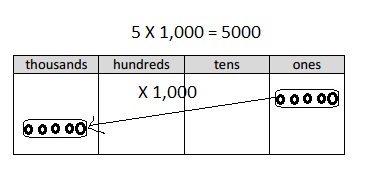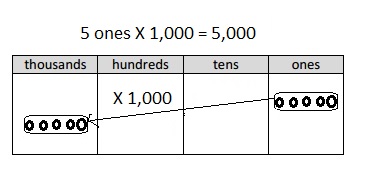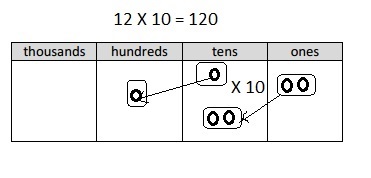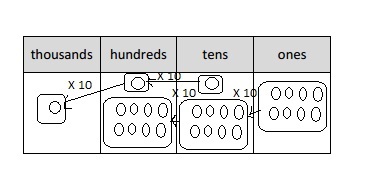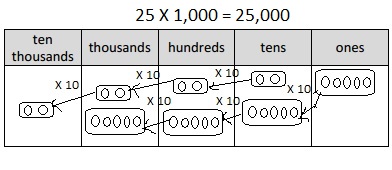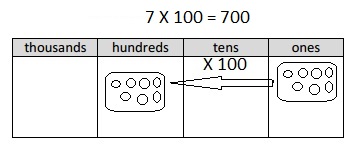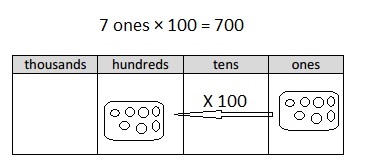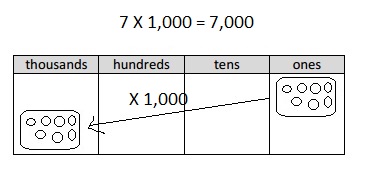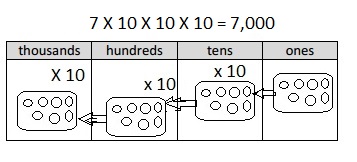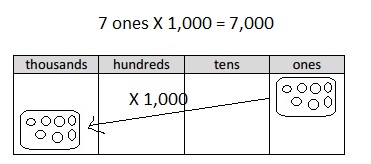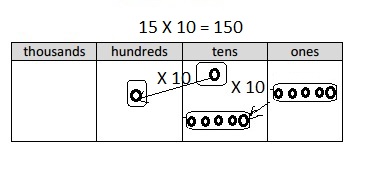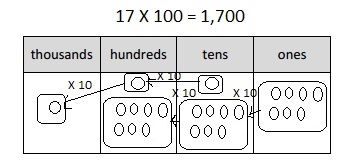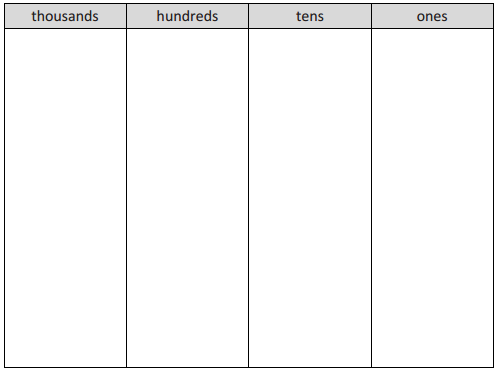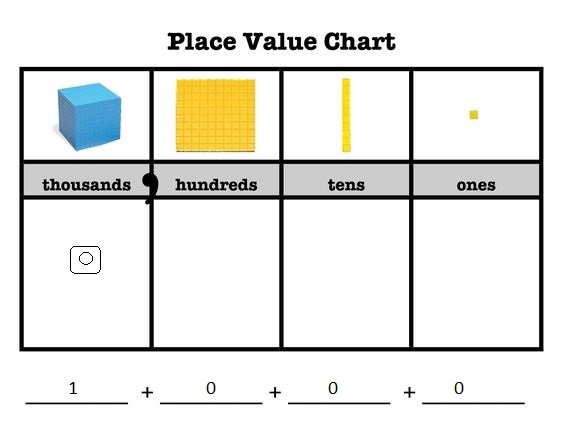Engage NY Eureka Math 4th Grade Module 3 Lesson 7 Answer Key
Eureka Math Grade 4 Module 3 Lesson 7 Sprint Answer Key
Multiply Multiples of 10, 100, and 1,000
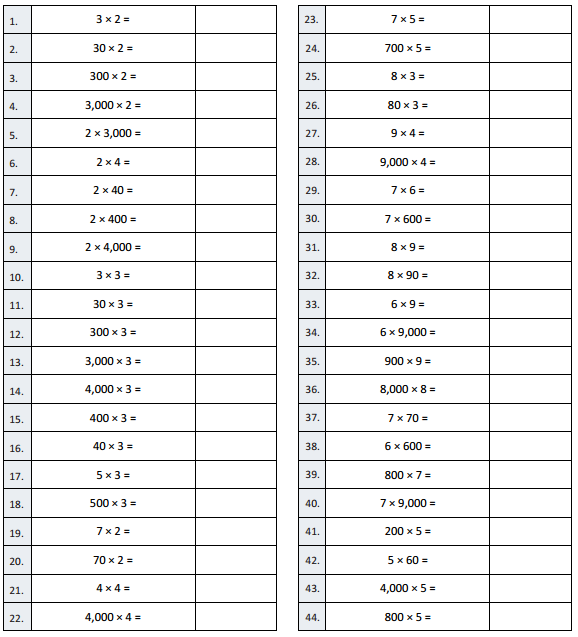
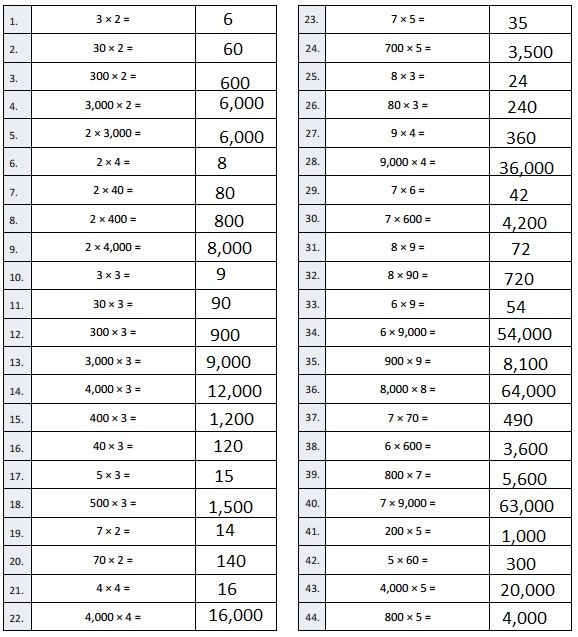
Question 1.
3 × 2 =
Answer:
3 X 2 = 6,
Explanation:
Given 3 X 2 = multiplying 3 with 2 we get 6,
3 X 2 = 6.
Question 2.
30 × 2 =
Answer:
30 X 2 =
3 X 10 X 2 = 60,
Explanation:
Given 30 X 2 = writing 30 as 3 X 10 and multiplying with 2
as 3 X 10 X 2 we get 60, So 30 X 2 = 60.
Question 3.
300 × 2 =
Answer:
300 X 2 =
3 X 100 X 2 = 600,
Explanation:
Given 300 X 2 = writing 300 as 3 X 100 and multiplying 2 we get 600,
3 X 100 X 2 = 600, so 300 X 2 = 600.
Question 4.
3,000 × 2 =
Answer:
3,000 X 2 =
3 X 1,000 X 2 = 6,000,
Explanation:
Given 3,000 X 2 = writing 3,000 as 3 X 1,000 and multiplying with 2
we get 6,000 as 3 X 1,000 X 2 = 6,000, So 3,000 X 2 = 6,000.
Question 5.
2 × 3,000 =
Answer:
2 X 3,000 =
2 X 3 X 1,000 = 6,000,
Explanation:
Given 2 X 3,000 = writing 3,000 as 3 X 1,000 and multiplying with
2 we get 6,000,2 X 3 X 1,000 = 6,000, So 2 X 3,000 = 6,000.
Question 6.
2 × 4 =
Answer:
2 X 4 = 8,
Explanation:
Given 2 X 4 = multiplying 2 with 4 we get 8,
2 X 4 = 8.
Question 7.
2 × 40 =
Answer:
2 X 40 =
2 X 4 X 10 = 80,
Explanation:
Given 2 X 40 = writing 40 as 4 X 10 and multiplying with 2 we get 80,
as 2 X 4 x 10 = 80, So 2 X 40 = 80.
Question 8.
2 × 400 =
Answer:
2 X 400 =
2 X 4 X 100 = 800,
Explanation:
Given 2 X 400 = writing 400 as 4 X 100 and multiplying with 2
we get 800 as 2 X 4 X 100 = 800, So 2 X 400 = 800.
Question 9.
2 × 4,000 =
Answer:
2 X 4,000 =
2 X 4 X 1,000 = 8,000,
Explanation:
Given 2 X 4,000 = writing 4,000 as 4 X 1,000 and multiplying with 2,
we get 8,000, as 2 X 4 X 1,000 = 8,000, So 2 X 4,000 = 8,000.
Question 10.
3 × 3 =
Answer:
3 X 3 = 9,
Explanation:
Given 3 X 3 = multiplying 3 with 3 we get 9,
3 X 3 = 9.
Question 11.
30 × 3 =
Answer:
30 X 3 =
3 X 10 X 3 = 90,
Explanation:
Given 30 X 3 = writing 30 as 3 X 10 and multiplying with 3 we get 90
as 3 X 10 X 3 = 90, So 30 X 3 = 90.
Question 12.
300 × 3 =
Answer:
300 X 3 =
3 X 100 X 3 = 900,
Explanation:
Given 300 X 3 = writing 300 as 3 X 100 and multiplying with 3
we get 900 as 3 X 100 X 3 = 900, So 300 X 3 = 900.
Question 13.
3,000 × 3 =
Answer:
3,000 X 3 =
3 X 1,000 X 3 = 9,000,
Explanation:
Given 3,000 X 3 = writing 3,000 as 3 X 1,000 and multiplying with 3 we get 9,000 as 3 X 1,000 X 3 = 9,000, So 3,000 X 3 = 9,000.
Question 14.
4,000 × 3 =
Answer:
4,000 X 3 =
4 X 1,000 X 3 = 12,000,
Explanation:
Given 4,000 X 3 = writing 4,000 as 4 X 1,000 and multiplying
with 3 we get 12,000 so 4 X 1,000 X 3 = 12,000, So 4,000 X 3 = 12,000.
Question 15.
400 × 3 =
Answer:
400 X 3 =
4 X 100 X 3 = 1,200,
Explanation:
Given 400 X 3 = writing 400 as 4 X 100 and multiplying
with 3 we get 1,200 as 4 X 100 X 3 = 1,200, So 400 X 3 = 1,200.
Question 16.
40 × 3 =
Answer:
40 X 3 =
4 X 10 X 3 = 120,
Explanation:
Given 40 X 3 = writing 40 as 4 X 10 multiplying with 3 we get 120
as 4 X 10 X 3 = 120, So 40 X 3 = 120.
Question 17.
5 × 3 =
Answer:
5 X 3 = 15,
Explanation:
Given 5 X 3 = multiplying 5 with 3 we get 15,
5 X 3 = 15.
Question 18.
500 × 3 =
Answer:
500 X 3 =
5 X 100 X 3 = 1,500,
Explanation:
Given 500 X 3 = writing 500 as 5 X 100 and multiplying with 3 we get 1,500 as 5 x 100 X 3 = 1,500, So 500 X 3 = 1,500.
Question 19.
7 × 2 =
Answer:
7 X 2 = 14,
Explanation:
Given 7 X 2 = multiplying 7 with 2 we get 14,
7 X 2 = 14.
Question 20.
70 × 2 =
Answer:
70 X 2 =
7 X 10 X 2 = 140,
Explanation:
Given 70 X 2 = writing 70 as 7 X 10 and multiplying with 2
we get 140 as 7 X 10 X 2 = 140, So 70 X 2 = 140.
Question 21.
4 × 4 =
Answer:
4 X 4 = 16,
Explanation:
Given 4 X 4 = multiplying 4 with 4 we get 16,
4 X 4 = 16.
Question 22.
4,000 × 4 =
Answer:
4,000 X 4 =
4 X 1,000 X 4 = 1,600,
Explanation:
Given 4,000 X 4 = writing 4,000 as 4 X 1,000 and multiplying
with 4 we get 1,600 as 4 X 1,000 X 4 = 1,600, So 4,000 X 4 = 1,600.
Question 23.
7 × 5 =
Answer:
7 X 5 = 35,
Explanation:
Given 7 X 5 = multiplying 7 with 5 we get 35,
7 X 5 = 35.
Question 24.
700 × 5 =
Answer:
700 X 5 =
7 x 100 X 5 = 3,500,
Explanation:
Given 700 X 5 = writing 700 as 7 X 100 and multiplying
with 5 we get 3,500 as 7 X 100 X 5 = 700, So 700 X 5 = 3,500.
Question 25.
8 × 3 =
Answer:
8 X 3 = 24,
Explanation:
Given 8 X 3 = multiplying 8 with 3 we get 24,
8 X 3 = 24.
Question 26.
80 × 3 =
Answer:
80 X 3 =
8 X 10 X 3 = 240,
Explanation:
Given 80 X 3 = writing 80 as 8 X 10 and multiplying
with 3 we get 240 as 8 X 10 X 3 = 240, So 80 X 3 = 240.
Question 27.
9 × 4 =
Answer:
9 X 4 = 36,
Explanation:
Given 9 X 4 = multiplying 9 with 4 we get 36,
9 X 4 = 36.
Question 28.
9,000 × 4 =
Answer:
9,000 x 4 =
9 X 1,000 X 4 = 36,000,
Explanation:
Given 9,000 X 4 = writing 9,000 as 9 X 1,000 and multiplying
with 4 we get 36,000 as 9 X 1,000 X 4 = 36,000,
So 9,000 X 4 = 36,000.
Question 29.
7 × 6 =
Answer:
7 X 6 = 42,
Explanation:
Given 7 X 6 = multiplying 7 with 6 we get 42,
7 X 6 = 42.
Question 30.
7 × 600 =
Answer:
7 X 600 =
7 X 6 X 100 = 4,200,
Explanation:
Given 7 X 600 = writing 600 as 6 X 100 and multiplying
with 7 we get 4,200 as 7 X 6 X 100 = 4,200 or 7 X 600 = 4,200.
Question 31.
8 × 9 =
Answer:
8 X 9 = 72,
Explanation:
Given 8 X 9 = multiplying 8 with 9 we get 72,
8 X 9 = 72.
Question 32.
8 × 90 =
Answer:
8 X 90 =
8 X 9 X 10 = 720,
Explanation:
Given 8 X 90 = writing 90 as 9 X 10 and multiplying
with 8 we get 720 as 8 x 9 X 10 = 720, So 8 X 90 = 720.
Question 33.
6 × 9 =
Answer:
6 X 9 = 54,
Explanation:
Given 6 X 9 = multiplying 6 with 9 we get 54,
6 X 9 = 54.
Question 34.
6 × 9,000 =
Answer:
6 X 9,000 =
6 X 9 X 1,000 = 54,000,
Explanation:
Given 6 X 9,000 = writing 9,000 as 9 X 1,000 and multiplying
with 6 we get 54,000 as 6 x 9 X 1,000 = 54,000, So 6 X 9,000 = 54,000.
Question 35.
900 × 9 =
Answer:
900 X 9 =
9 X 100 X 9 = 8,100,
Explanation:
Given 900 X 9 = writing 900 as 9 X 100 and multiplying
with 9 we get 8,100 as 9 X 100 X 9 = 8,100, So 900 X 9 = 8,100.
Question 36.
8,000 × 8 =
Answer:
8,000 X 8 =
8 X 1,000 X 8 = 64,000,
Explanation:
Given 8,000 X 8 = writing 8,000 as 8 X 1,000 and multiplying
with 8 we get 64,000 as 8 X 1,000 X 8 = 64,000, So 8,000 X 8 = 64,000.
Question 37.
7 × 70 =
Answer:
7 X 70 =
7 X 7 X 10 = 490,
Explanation:
Given 7 X 70 = writing 70 as 7 X 10 and multiplying
with 7 we get 490 as 7 X 7 X 10 = 490, So 7 X 70 = 490.
Question 38.
6 × 600 =
Answer:
6 X 600 =
6 X 6 X 100 = 3,600,
Explanation:
Given 6 X 600 = writing 600 as 6 X 100 and multiplying
with 6 we get 3,600 as 6 x 6 X 100 = 3,600, So 6 X 600 = 3,600.
Question 39.
800 × 7 =
Answer:
800 X 7 =
8 X 100 X 7 = 5,600,
Explanation:
Given 800 X 7 = writing 800 as 8 x 100 and multiplying
with 7 we get 5,600 as 8 X 100 X 7 = 5,600, So 800 X 7 = 5,600.
Question 40.
7 × 9,000 =
Answer:
7 X 9,000 =
7 X 9 X 1,000 = 63,000,
Explanation:
Given 7 X 9,000 = writing 9,000 as 9 X 1,000 and multiplying
with 7 we get 63,000 as 7 X 9 X 1,000 = 63,000, So 7 X 9,000 = 63,000.
Question 41.
200 × 5 =
Answer:
200 X 5 =
2 X 100 X 5 = 1,000,
Explanation:
Given 200 X 5 = writing 200 as 2 X 100 and multiplying
with 5 we get 1,000 as 2 X 100 X 5 = 1,000, So 200 X 5 = 1,000.
Question 42.
5 × 60 =
Answer:
5 X 60 =
5 X 6 X 10 =300,
Explanation:
Given 5 X 60 = writing 60 as 6 X 10 and multiplying
with 5 we get 300 as 5 X 6 X 10 = 300, So 5 X 60 = 300.
Question 43.
4,000 × 5 =
Answer:
4,000 X 5 =
4 X 1,000 X 5 = 20,000,
Explanation:
Given 4,000 X 5 = writing 4,000 as 4 X 1,000 and multiplying
with 5 we get 20,000 as 4 x 1,000 X 5 = 20,000, So 4,000 X 5 = 20,000.
Question 44.
800 × 5 =
Answer:
800 X 5 = 4,000,
8 X 100 X 5 = 4,000,
Explanation:
Given 800 X 5 = writing 800 as 8 X 100 and multiplying
with 5 we get 4,000 as 8 X 100 X 5 = 4,000, So 800 X 5 = 4,000.
Multiply Multiples of 10, 100, and 1,000
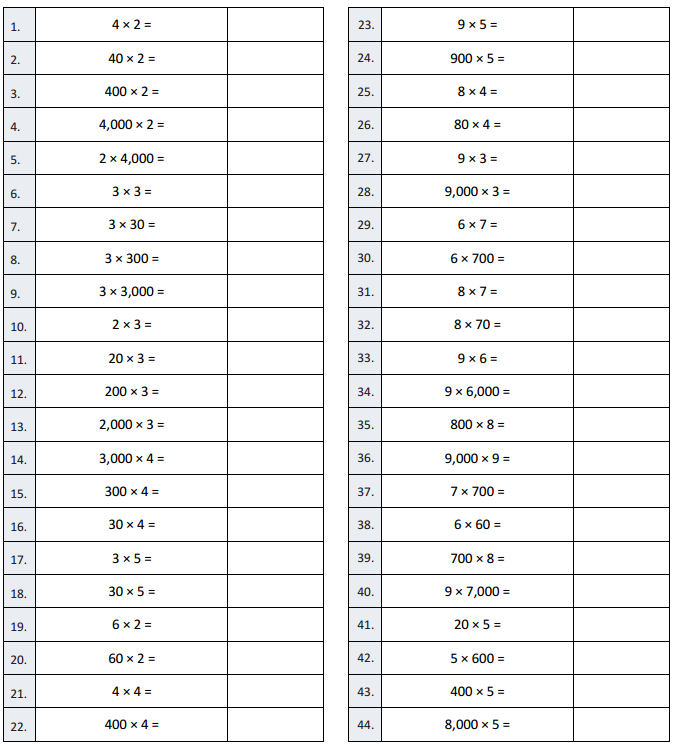

Question 1.
4 × 2 =
Answer:
4 X 2 = 8,
Explanation:
Given 4 X 2 = multiplying 4 with 2 we get 8,
4 X 2 = 8.
Question 2.
40 × 2 =
Answer:
40 X 2 =
4 X 10 X 2 = 80,
Explanation:
Given 40 X 2 = writing 40 as 4 X 10 and multiplying
with 2 we get 80 as 4 X 10 X 2 = 80, So 40 X 2 = 80.
Question 3.
400 × 2 =
Answer:
400 X 2 =
4 X 100 X 2 = 800,
Explanation:
Given 400 X 2 = writing 400 as 4 X 100 and multiplying
with 2 we get 800 as 4 X 100 X 2 = 800, So 400 X 2 = 800.
Question 4.
4,000 × 2 =
Answer:
4,000 X 2 =
4 X 1,000 X 2 = 8,000,
Explanation:
Given 4,000 X 2 = writing 4,000 as 4 X 1,000 and multiplying with 2,
we get 8,000, as 4 X 1,000 X 2 = 8,000, So 4,000 X 2 = 8,000.
Question 5.
2 × 4,000 =
Answer:
2 X 4,000 =
2 X 4 X 1,000 = 8,000,
Explanation:
Given 2 X 4,000 = writing 4,000 as 4 X 1,000 and multiplying with 2,
we get 8,000, as 2 X 4 X 1,000 = 8,000, So 2 X 4,000 = 8,000.
Question 6.
3 × 3 =
Answer:
3 X 3 = 9,
Explanation:
Given 3 X 3 = multiplying 3 with 3 we get 9,
3 X 3 = 9.
Question 7.
3 × 30 =
Answer:
3 X 30 =
3 X 3 X 10 = 90,
Explanation:
Given 3 X 30 = writing 30 as 3 X 10 and multiplying with 3 we get 90
as 3 X 3 X 10 = 90, So 3 X 30 = 90.
Question 8.
3 × 300 =
Answer:
3 X 300 =
3 X 3 X 100 = 900,
Explanation:
Given 3 X 300 = writing 300 as 3 X 100 and multiplying with 3
we get 900 as 3 X 3 X 100 = 900, So 3 X 300 = 900.
Question 9.
3 × 3,000 =
Answer:
3 X 3,000 =
3 X 3 X 1,000 = 9,000,
Explanation:
Given 3 X 3,000 = writing 3,000 as 3 X 1,000 and multiplying with 3 we get 9,000 as 3 X 3 X 1,000 = 9,000, So 3 X 3,000 = 9,000.
Question 10.
2 × 3 =
Answer:
2 X 3 = 6,
Explanation:
Given 2 X 3 = multiplying 2 with 3 we get 6,
2 X 3 = 6.
Question 11.
20 × 3 =
Answer:
20 X 3 =
2 x 10 X 3 = 60,
Explanation:
Given 20 X 3 = writing 20 as 2 X 10 and multiplying with 3 we get 60
as 2 X 10 X 3 = 60, So 20 X 3 = 60.
Question 12.
200 × 3 =
Answer:
200 X 3 =
2 X 100 X 3 = 600,
Explanation:
Given 200 X 3 = writing 200 as 2 X 100 and multiplying
with 3 we get 600 as 2 X 100 X 3 = 600, So 200 X 3 = 600.
Question 13.
2,000 × 3 =
Answer:
2,000 X 3 =
2 X 1,000 X 3 = 6,000,
Explanation:
Given 2,000 X 3 = writing 2,000 as 2 X 1,000 and
multiplying with 3 we get 6,000 as 2 X 1,000 X 3 = 6,000,
So 2,000 X 3 = 6,000.
Question 14.
3,000 × 4 =
Answer:
3,000 X 4 =
3 X 1,000 X 4 = 12,000,
Explanation:
Given 3,000 X 4 = writing 3,000 as 3 X 1,000 and
multiplying with 4 we get 12,000 as 3 X 1,000 X 4 = 12,000,
So 3,000 X 4 = 12,000.
Question 15.
300 × 4 =
Answer:
300 X 4 =
3 X 100 X 4 = 1,200,
Explanation:
Given 300 X 4 = writing 300 as 3 X 100 and multiplying
with 4 we get 1,200 as 3 X 100 X 4 = 1,200, So 300 X 4 = 1,200.
Question 16.
30 × 4 =
Answer:
30 X 4 =
3 X 10 X 4 = 120,
Explanation:
Given 30 X 4 = writing 30 as 3 X 10 and multiplying
with 4 we get 120 as 3 X 10 X 4 = 120, So 30 X 4 = 120.
Question 17.
3 × 5 =
Answer:
3 X 5 = 15,
Explanation:
Given 3 X 5 = multiplying 3 with 5 we get 15
as 3 X 5 = 15, So 3 X 5 = 15.
Question 18.
30 × 5 =
Answer:
30 X 5 =
3 X 10 X 5 = 150,
Explanation:
Given 30 X 5 = writing 30 as 3 X 10 and multiplying
with 5 we get 150 as 3 X 10 X 5 = 150, So 30 X 5 = 150.
Question 19.
6 × 2 =
Answer:
6 X 2 = 12,
Explanation:
Given 6 X 2 = multiplying 6 with 2 we get 12
as 6 X 2 = 12, So 6 X 2 = 12.
Question 20.
60 × 2 =
Answer:
60 X 2 =
6 X 10 X 2 = 120,
Explanation:
Given 60 X 2 = writing 60 as 6 X 10 and multiplying
with 2 we get 120 as 6 X 10 X 2 = 120, So 60 X 2 = 120.
Question 21.
4 × 4 =
Answer:
4 X 4 = 16,
Explanation:
Given 4 X 4 = multiplying 4 with 4 we get 16
as 4 X 4 = 16, So 4 X 4 = 16.
Question 22.
400 × 4 =
Answer:
400 X 4 =
4 X 100 X 4 = 1,600,
Explanation:
Given 400 X 4 = writing 400 as 4 X 100 and multiplying
with 4 we get 1,600 as 4 X 100 X 4 = 1,600, So 400 X 4 = 1,600.
Question 23.
9 × 5 =
Answer:
9 X 5 = 45,
Explanation:
Given 9 X 5 = multiplying 9 with 5 we get 45 as
9 X 5 = 45.
Question 24.
900 × 5 =
9 X 100 X 5 = 4,500,
Explanation:
Given 900 X 5 = writing 900 as 9 X 100 and multiplying
with 5 we get 4,500 as 9 X 100 X 5 = 4,500, So 900 X 5 = 4,500.
Question 25.
8 × 4 =
Answer:
8 X 4 = 32,
Explanation:
Given 8 X 4 = multiplying 8 with 4 we get 32 as
8 X 4 = 32.
Question 26.
80 × 4 =
Answer:
80 X 4 =
8 X 10 X 4 = 320,
Explanation:
Given 80 X 4 = writing 80 as 8 X 10 and multiplying
with 4 we get 320 as 8 X 10 X 4 = 320, So 80 X 4 = 320.
Question 27.
9 × 3 =
Answer:
9 X 3 = 27,
Explanation:
Given 9 X 3 = multiplying 9 with 3 we get 27 as
9 X 3 = 27.
Question 28.
9,000 × 3 =
Answer:
9,000 X 3 =
9 X 1,000 X 3 = 27,000,
Explanation:
Given 9,000 X 3 = writing 9,000 as 9 X 1,000 and
multiplying with 3 we get 27,000 as 9 X 1,000 X 3 = 27,000,
So 9,000 X 3 = 27,000.
Question 29.
6 × 7 =
Answer:
6 X 7 = 42,
Explanation:
Given 6 X 7 = multiplying 6 with 7 we get 42 as
6 X 7 = 42.
Question 30.
6 × 700 =
Answer:
6 X 700 =
6 X 7 X 100 = 4,200,
Explanation:
Given 6 X 700 = writing 700 as 7 X 100 and multiplying
with 6 we get 4,200 as 6 X 7 X 100 = 4,200, So 6 X 700 = 4,200.
Question 31.
8 × 7 =
Answer:
8 X 7 = 56,
Explanation:
Given 8 X 7 = multiplying 8 with 7 we get 56 as
8 X 7 = 56.
Question 32.
8 × 70 =
Answer:
8 X 70 =
8 X 7 X 10 = 560,
Explanation:
Given 8 X 70 = writing 70 as 7 X 10 and multiplying
with 8 we get 560 as 8 x 7 X 10 = 560, So 8 X 70 = 560.
Question 33.
9 × 6 =
Answer:
9 X 6 = 54,
Explanation:
Given 9 X 6 = multiplying 9 with 6 we get 54 as
9 X 6 = 54.
Question 34.
9 × 6,000 =
Answer:
9 X 6,000 =
9 X 6 X 1,000 = 54,000,
Explanation:
Given 9 X 6,000 = writing 6,000 as 6 X 1,000 and multiplying with 9,
we get 54,000, as 9 X 6 X 1,000 = 54,000, So 9 X 6,000 = 54,000.
Question 35.
800 × 8 =
Answer:
800 X 8 =
8 X 100 X 8 = 6,400,
Explanation:
Given 800 X 8 = writing 800 as 8 X 100 and multiplying
with 8 we get 6,400 as 8 X 100 X 8 = 6,400, So 800 X 8 = 6,400.
Question 36.
9,000 × 9 =
Answer:
9,000 x 9 =
9 X 1,000 X 9 = 81,000,
Explanation:
Given 9,000 X 9 = writing 9,000 as 9 X 1,000 and multiplying
with 9 we get 81,000 as 9 X 1,000 X 9 = 81,000,
So 9,000 X 9 = 81,000.
Question 37.
7 × 700 =
Answer:
7 X 700 =
7 X 7 X 100 = 4,900,
Explanation:
Given 7 X 700 = writing 700 as 7 X 100 and multiplying
with 7 we get 4,900 as 7 X 7 X 100 = 4,900, So 7 X 700 = 4,900.
Question 38.
6 × 60 =
Answer:
6 X 60 =
6 X 6 X 10 = 360,
Explanation:
Given 6 X 60 = writing 60 as 6 X 10 and multiplying
with 6 we get 360 as 6 x 6 X 10 = 360, So 6 X 60 = 360.
Question 39.
700 × 8 =
Answer:
700 X 8 =
7 X 100 X 8 = 5,600,
Explanation:
Given 700 X 8 = writing 700 as 7 X 100 and multiplying
with 8 we get 5,600 as 7 X 100 X 8 = 5,600, So 700 X 8 = 5,600.
Question 40.
9 × 7,000 =
Answer:
9 X 7000 =
9 X 7 X 1,000 = 63,000,
Explanation:
Given 9 X 7,000 = writing 7,000 as 7 X 1,000 and multiplying with 9,
we get 63,000, as 9 X 7 X 1,000 = 63,000, So 9 X 7,000 = 63,000.
Question 41.
20 × 5 =
Answer:
20 X 5 =
2 X 10 X 5 = 100,
Explanation:
Given 20 X 5 = writing 20 as 2 X 10 and multiplying
with 5 we get 100 as 2 X 10 X 5 = 100, So 20 X 5 = 100.
Question 42.
5 × 600 =
Answer:
5 X 600 =
5 X 6 X 100 = 3,000,
Explanation:
Given 5 X 600 = writing 600 as 6 X 100 and multiplying
with 5 we get 3,000 as 5 X 6 X 100 = 3,000, So 5 X 600 = 3,000.
Question 43.
400 × 5 =
Answer:
400 X 5 =
4 X 100 X 5 = 2,000,
Explanation:
Given 400 X 5 = writing 400 as 4 X 100 and multiplying
with 5 we get 2,000 as 4 X 100 X 5 = 2,000, So 400 X 5 = 2,000.
Question 44.
8,000 × 5 =
Answer:
8,000 x 5 =
8 X 1,000 X 5 = 40,000,
Explanation:
Given 8,000 X 5 = writing 8,000 as 8 X 1,000 and multiplying
with 5 we get 40,000 as 8 X 1,000 X 5 = 40,000,
So 8,000 X 5 = 40,000.
Eureka Math Grade 4 Module 3 Lesson 7 Problem Set Answer Key
Question 1.
Represent the following expressions with disks, regrouping as necessary, writing a matching expression, and recording the partial products vertically as shown below.
a. 1 × 43
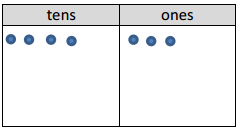
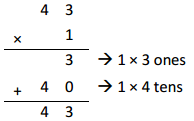
Answer:
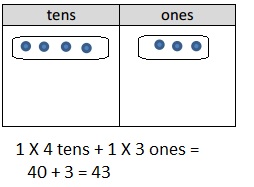
43
X1
3—-1 X 3 ones
+40—-1 X 4 tens
43
Explanation:
Represented the following expression 1 X43 with disks,
regrouped as necessary, wrote a matching expression, and
recorded the partial products vertically as shown above 1 X 43 = 43.
b. 2 × 43
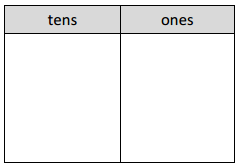
Answer:
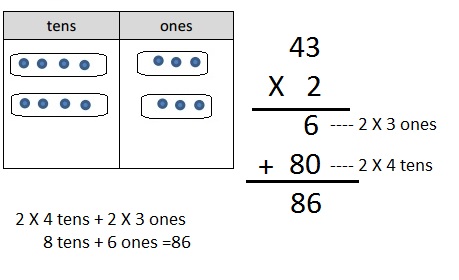
Explanation:
Represented the following expression 2 X 43 with disks,
regrouped as necessary, wrote a matching expression, and
recorded the partial products vertically as shown above 2 X 43 = 86.
c. 3 × 43
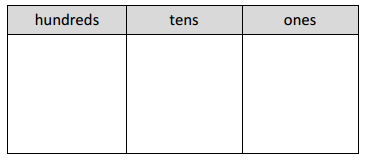
Answer:
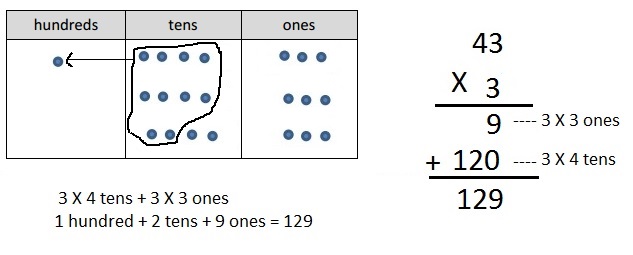
Explanation:
Represented the following expression 3 X 43 with disks,
regrouped as necessary, wrote a matching expression, and
recorded the partial products vertically as shown above 3 X 43 = 129.
d. 4 × 43

Answer:
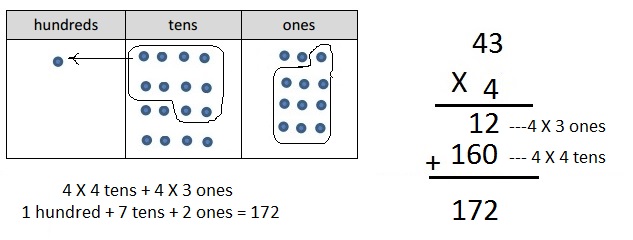
Explanation:
Represented the following expression 4 X 43 with disks,
regrouped as necessary, wrote a matching expression, and
recorded the partial products vertically as shown above 4 X 43 = 172.
Question 2.
Represent the following expressions with disks,
regrouping as necessary. To the right, record the partial
products vertically.
a. 2 × 36

Answer:
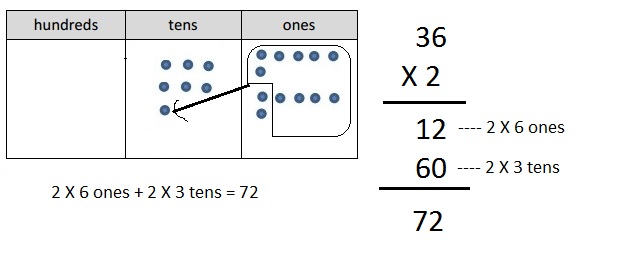
Explanation:
Represented the following expression 2 X 36 with disks,
regrouped as necessary. To the right, record the partial
products vertically as 2 X 36 = 72 as shown above.
b. 3 × 61

Answer:
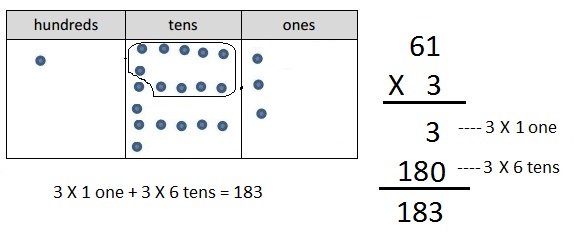
Explanation:
Represented the following expression 3 X 61 with disks,
regrouped as necessary. To the right, recorded the partial
products vertically as 3 X 61 = 183 as shown above.
c. 4 × 84

Answer:
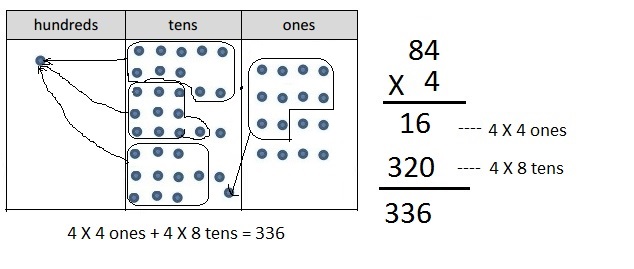
Explanation:
Represented the following expression 4 X 84 with disks,
regrouped as necessary. To the right, recorded the partial
products vertically as 4 X 84 = 336 as shown above.
Eureka Math Grade 4 Module 3 Lesson 7 Exit Ticket Answer Key
Represent the following expressions with disks, regrouping as necessary. To the right, record the partial products vertically.
Question 1.
6 × 41

Answer:
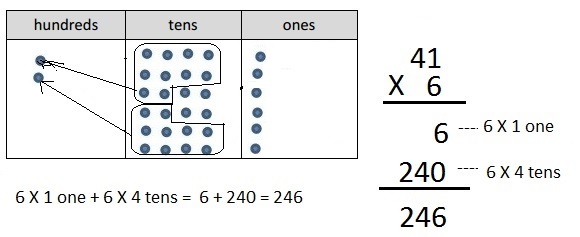
Explanation:
Represented the following expression 6 X 41 with disks,
regrouped as necessary. To the right, recorded the partial
products vertically as 6 X 41 = 246 as shown above.
Question 2.
7 × 31

Answer:
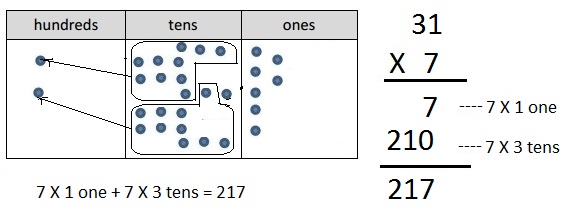
Explanation:
Represented the following expression 7 X 31 with disks,
regrouped as necessary. To the right, recorded the partial
products vertically as 7 X 31 = 217 as shown above.
Eureka Math Grade 4 Module 3 Lesson 7 Homework Answer Key
Question 1.
Represent the following expressions with disks, regrouping as necessary, writing a matching expression, and recording the partial products vertically.
a. 3 × 24
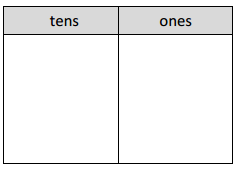
Answer:
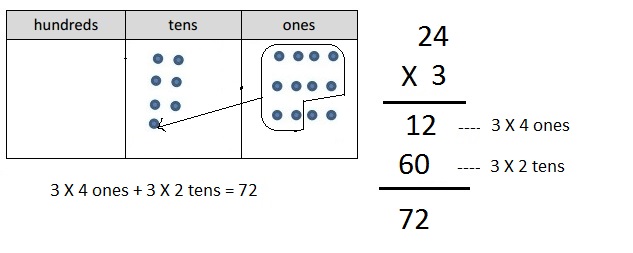
Explanation:
Represented the following expression 3 X 24 with disks,
regrouped as necessary. To the right, recorded the partial
products vertically as 3 X 24 = 72 as shown above.
b. 3 × 42
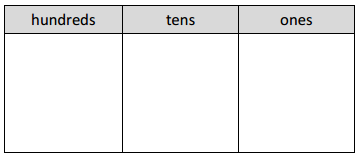
Answer:
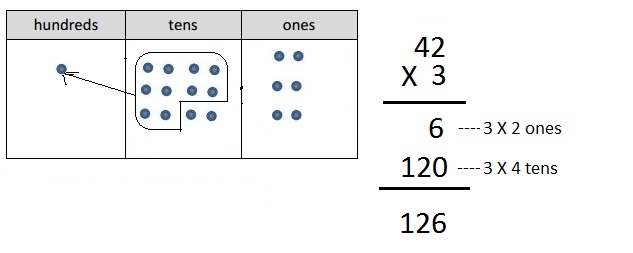
Explanation:
Represented the following expression 3 X 42 with disks,
regrouped as necessary. To the right, recorded the partial
products vertically as 3 X 42 = 126 as shown above.
c. 4 × 34

Answer:
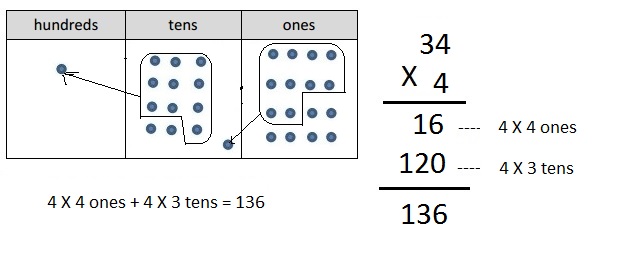
Explanation:
Represented the following expression 4 X 34 with disks,
regrouped as necessary. To the right, recorded the partial
products vertically as 4 X 34 = 136 as shown above.
Question 2.
Represent the following expressions with disks, regrouping as necessary. To the right, record the partial products vertically.
a. 4 × 27

Answer:
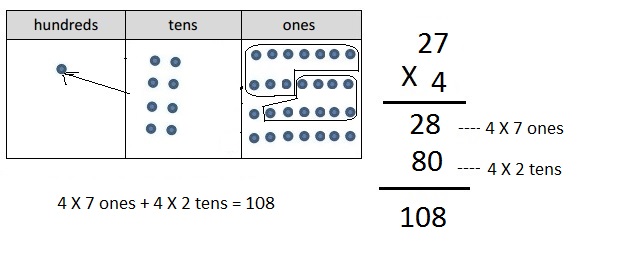
Explanation:
Represented the following expression 4 X 27 with disks,
regrouped as necessary. To the right, recorded the partial
products vertically as 4 X 27 = 108 as shown above.
b. 5 × 42

Answer:
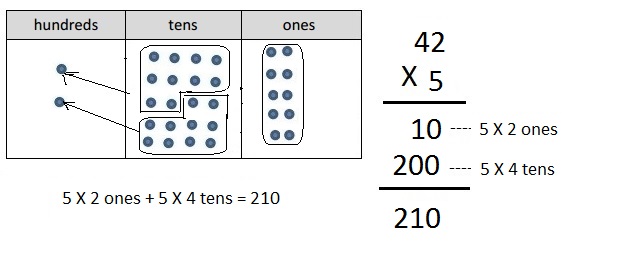
Explanation:
Represented the following expression 5 X 42 with disks,
regrouped as necessary. To the right, recorded the partial
products vertically as 5 X 42 = 210 as shown above.
Question 3.
Cindy says she found a shortcut for doing multiplication problems.
When she multiplies 3 × 24, she says, “3 × 4 is 12 ones,
or 1 ten and 2 ones. Then, there’s just 2 tens left in 24,
so add it up, and you get 3 tens and 2 ones.”
Do you think Cindy’s shortcut works?
Explain your thinking in words, and justify your
response using a model or partial products.
Answer:
No, Cindy’s shortcut will not work,
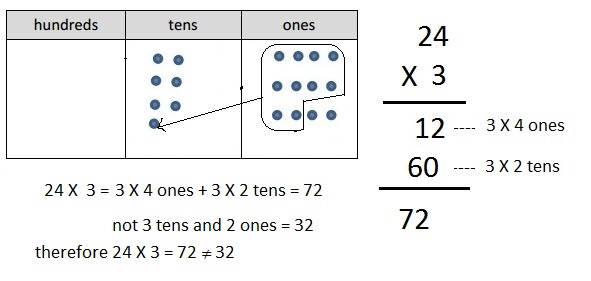
Explanation:
Given Cindy says she found a shortcut for doing multiplication problems.
When she multiplies 3 × 24, she says, “3 × 4 is 12 ones,
or 1 ten and 2 ones. Then, there’s just 2 tens left in 24,
so add it up, and you get 3 tens and 2 ones.”
No I don’t think Cindy’s shortcut works,
because 3 X 24 = 72 not 32,
Explained my thinking in words, and justified
using a model or partial products as show above.
Eureka Math Grade 4 Module 3 Lesson 7 Template Answer Key
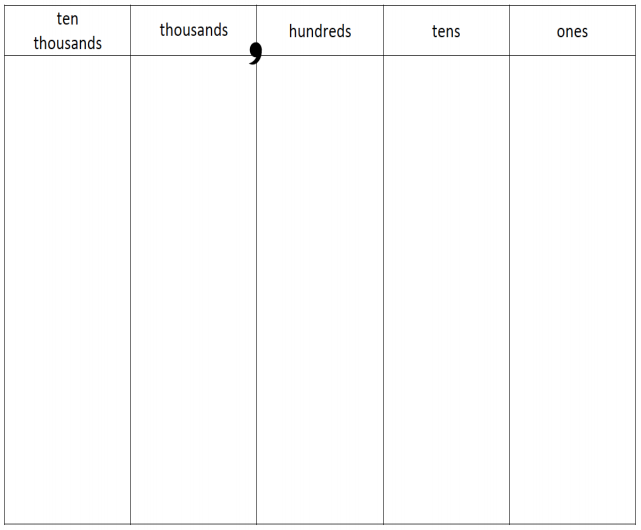
_10,000____________
ten thousand value chart
Answer:
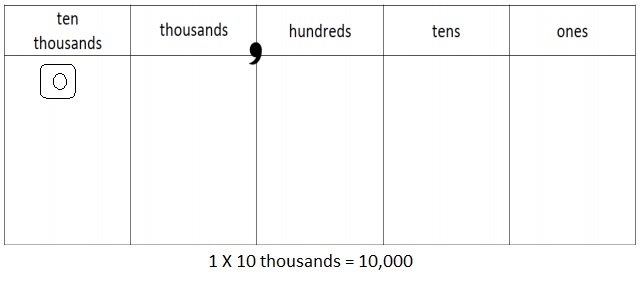
Explanation:
A place value chart is diagram that helps us to find and
compare the place value of the digits in numbers through
millions. The place value of a digit in the place value chart
increases by ten times as we shift to the left and decreases
by ten times as we shift to the right.
For example for ten thousand place value chart where we write
10,000 as 10 in thousands place, 0 in hundreds place, 0 in tens place
and 0 in ones place as shown above.
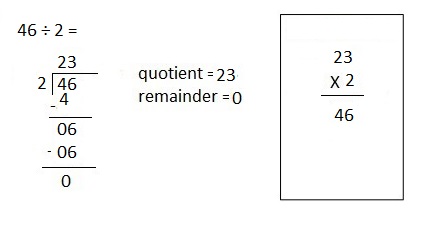
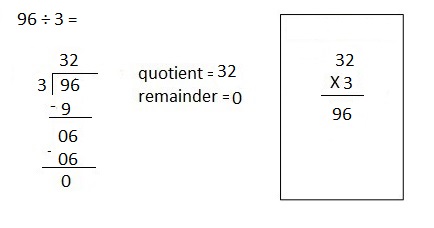
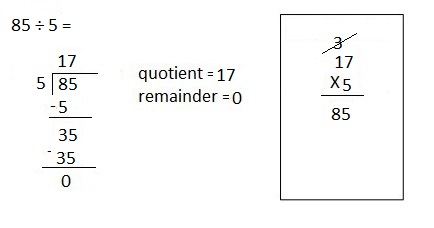

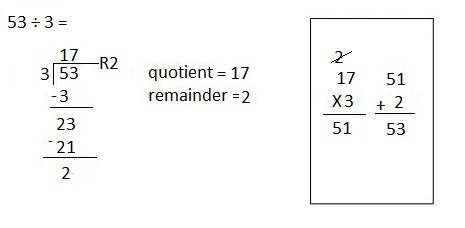

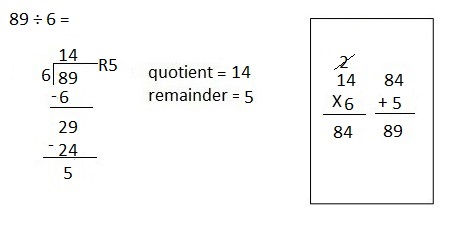
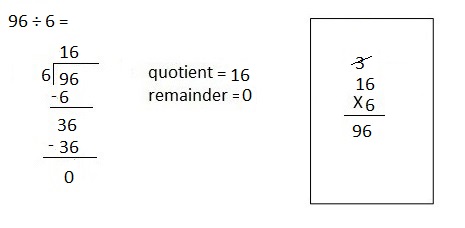
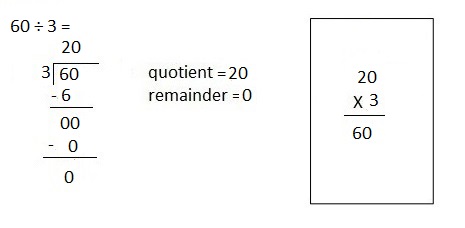
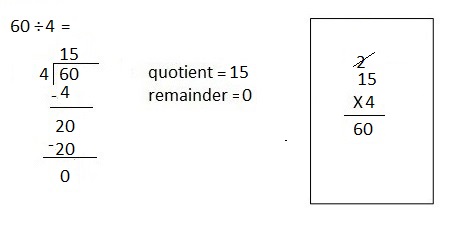
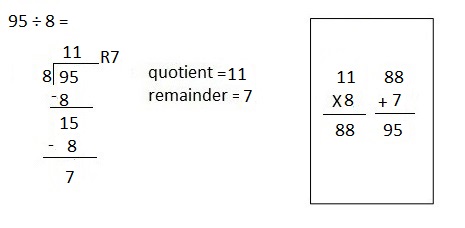
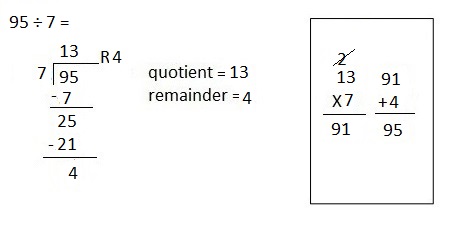
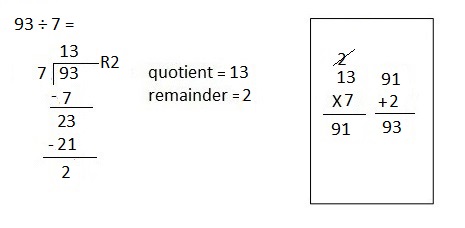

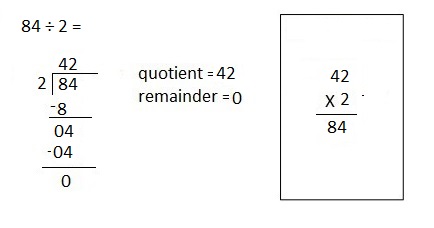
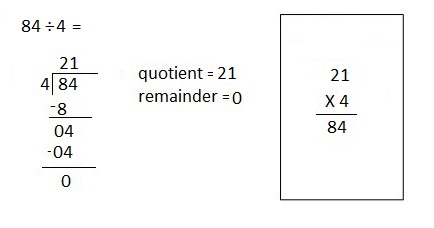
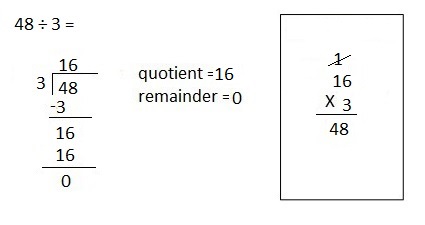
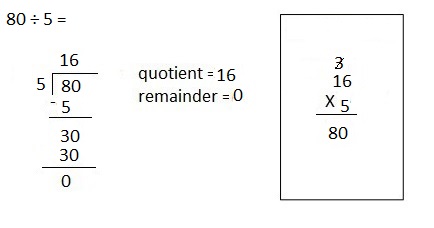
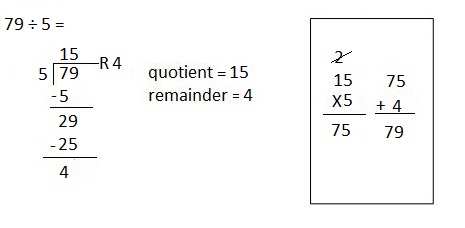
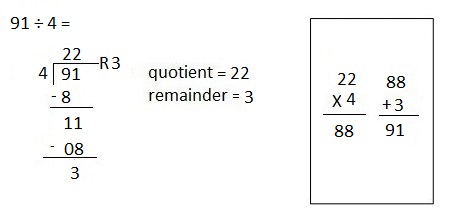
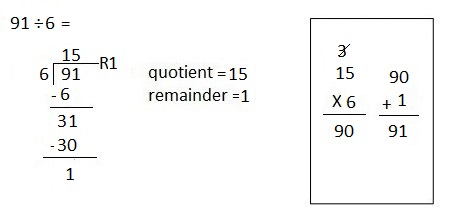
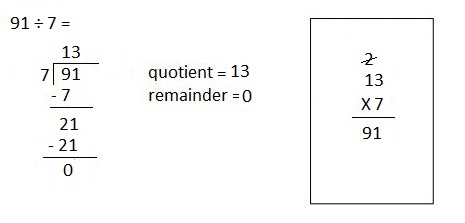
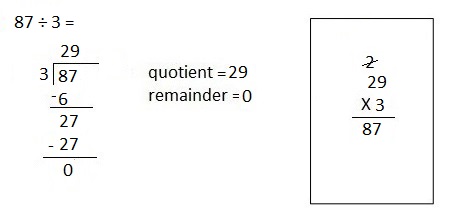
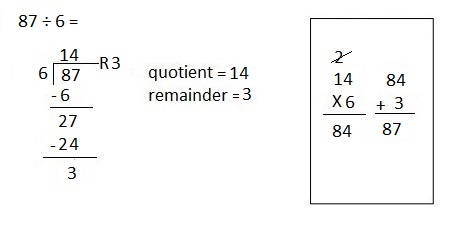
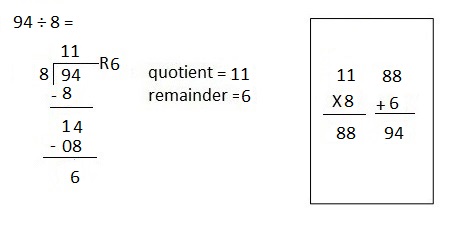
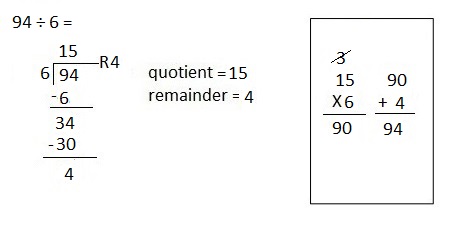
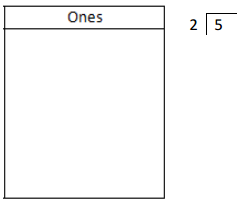
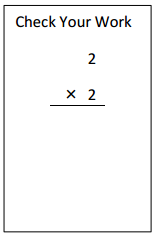

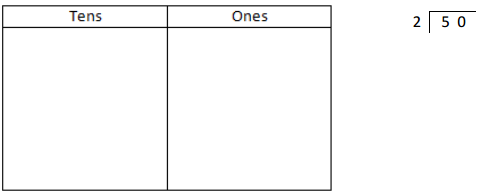
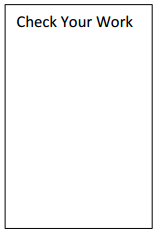

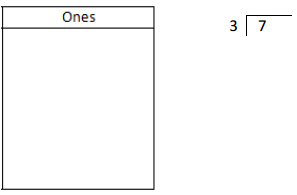

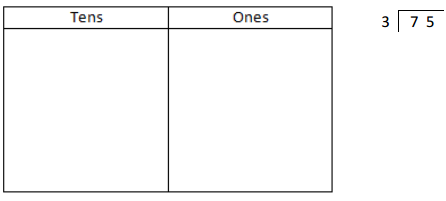

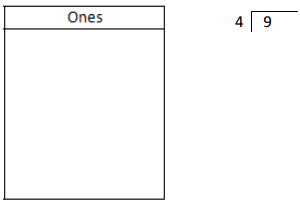
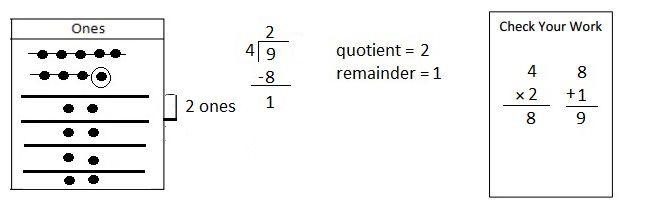
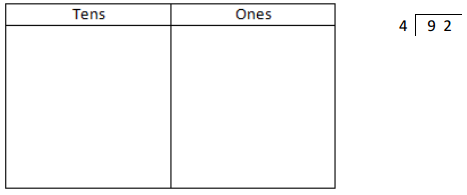

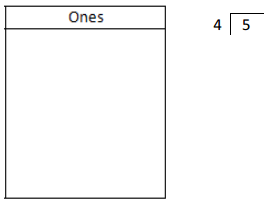

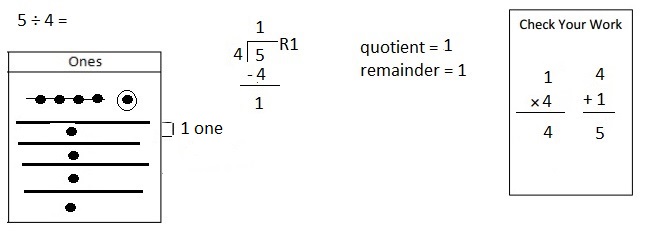
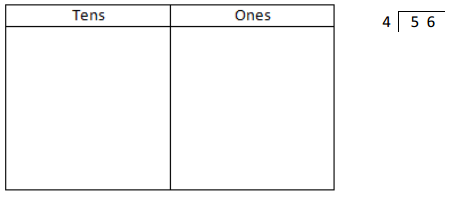

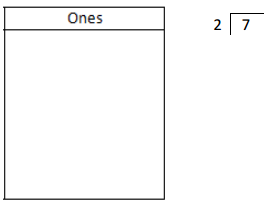
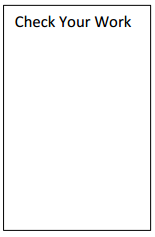
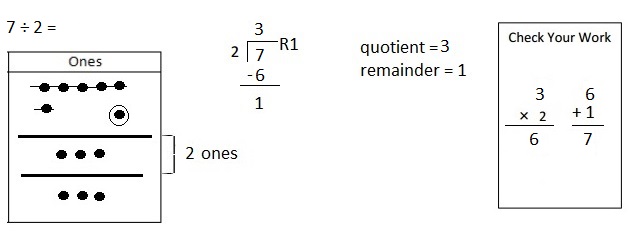
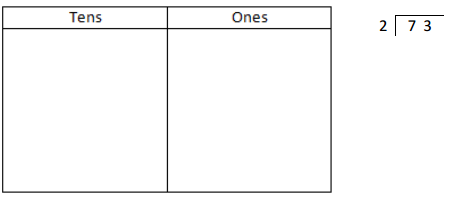

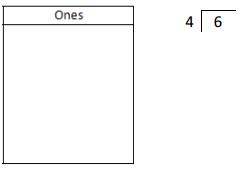
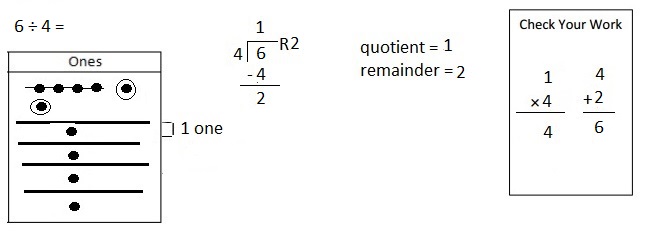

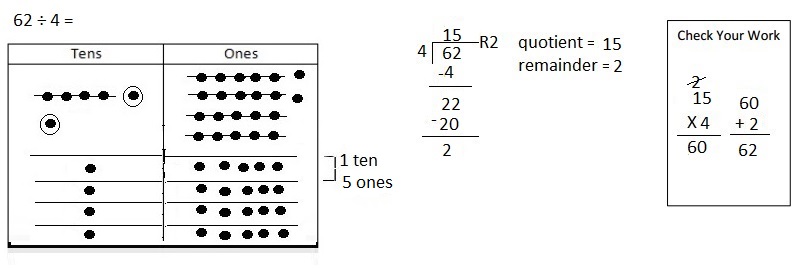
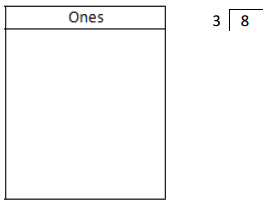

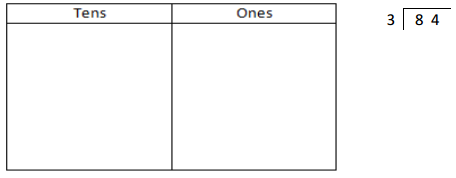

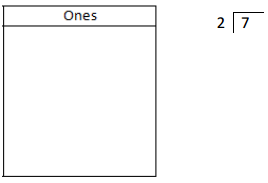
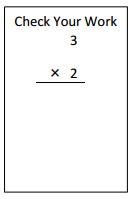
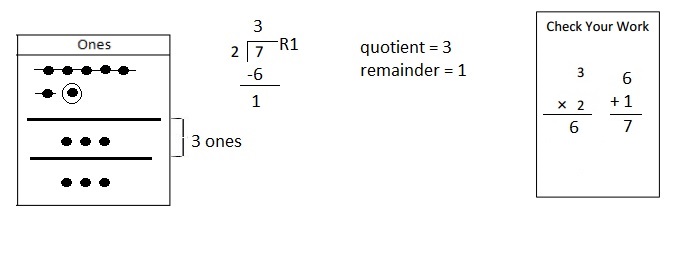
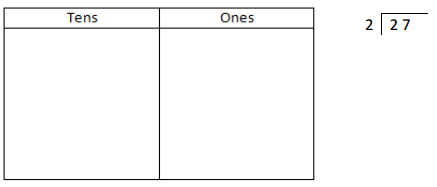
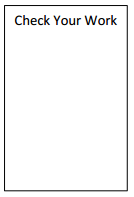


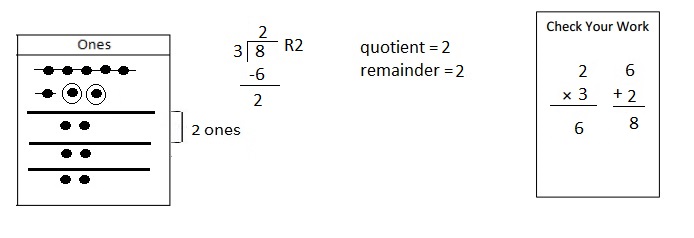
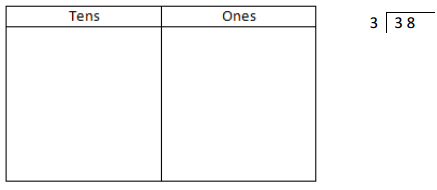

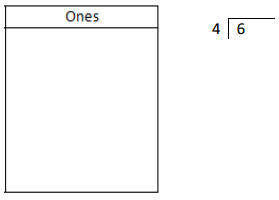

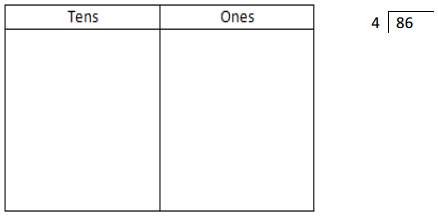

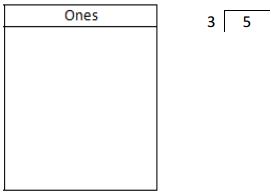


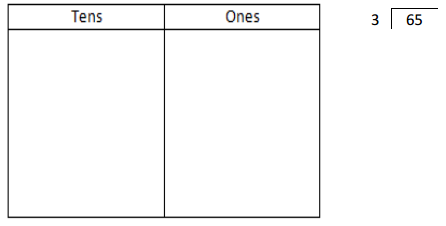

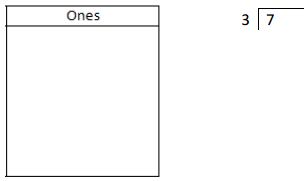
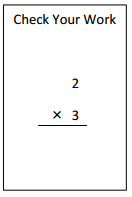

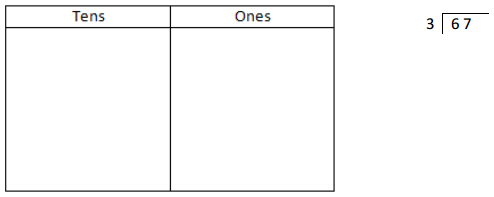
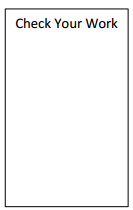

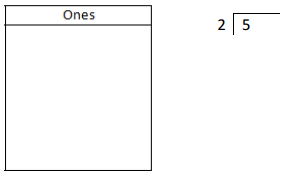

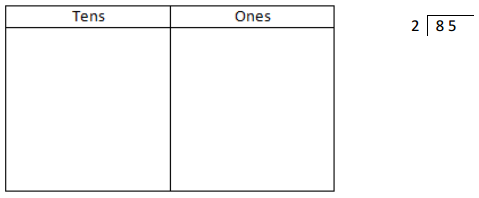

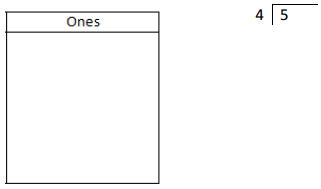

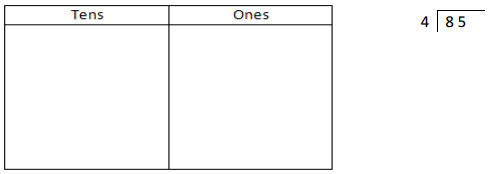

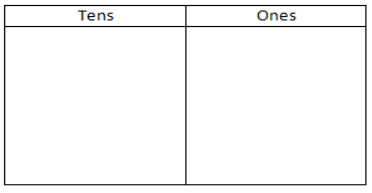
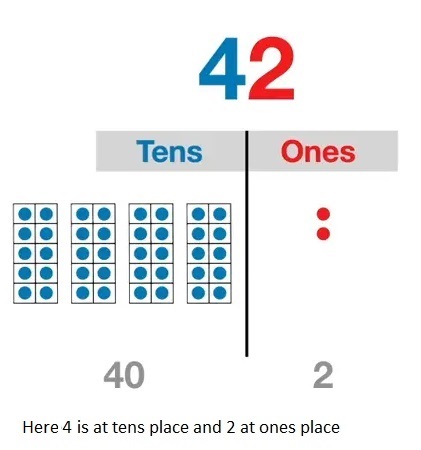
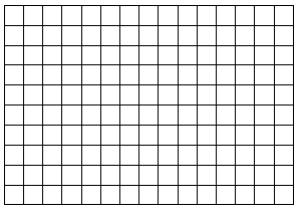
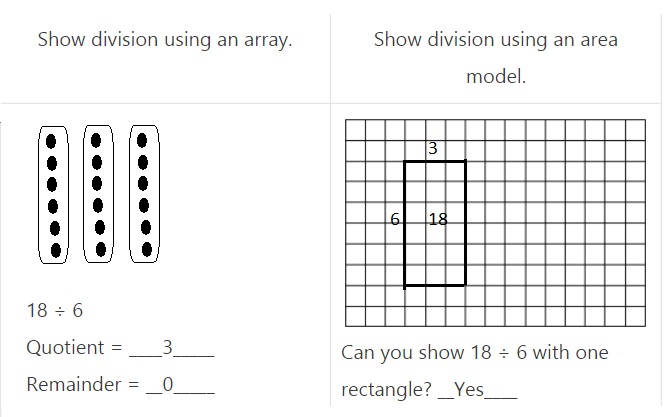
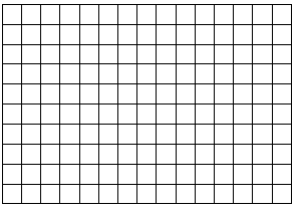
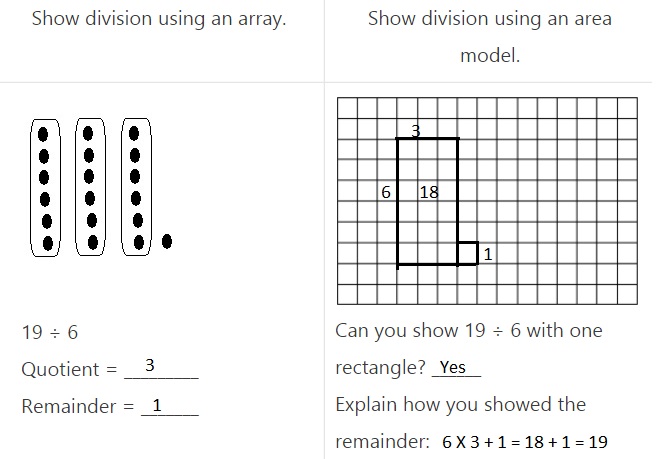


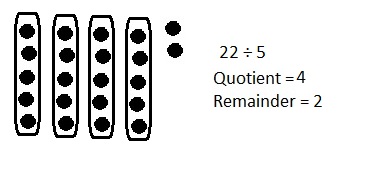
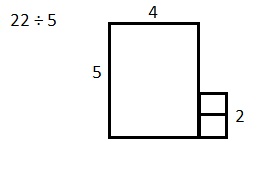

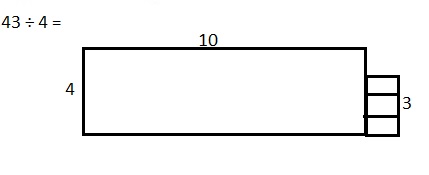
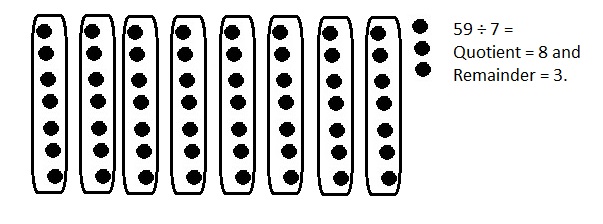
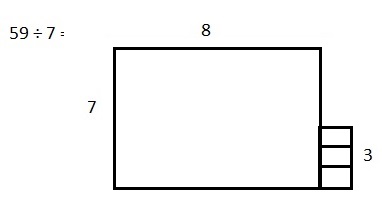
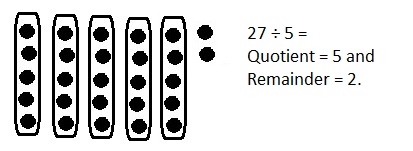
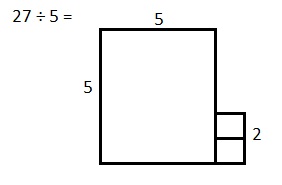
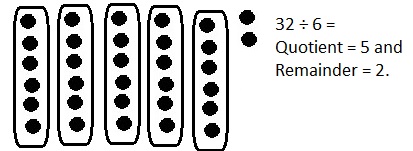
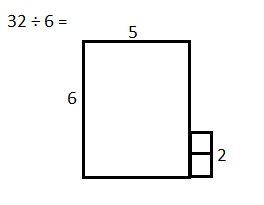
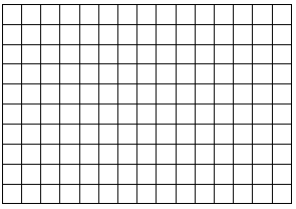
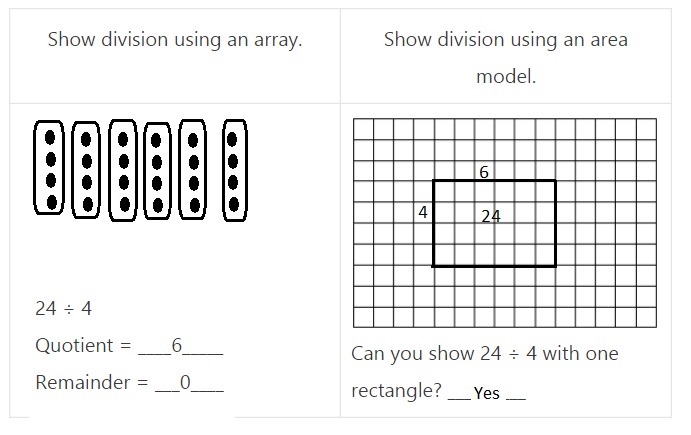
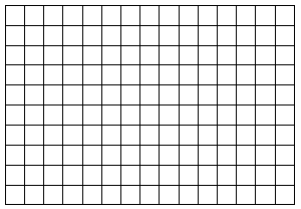
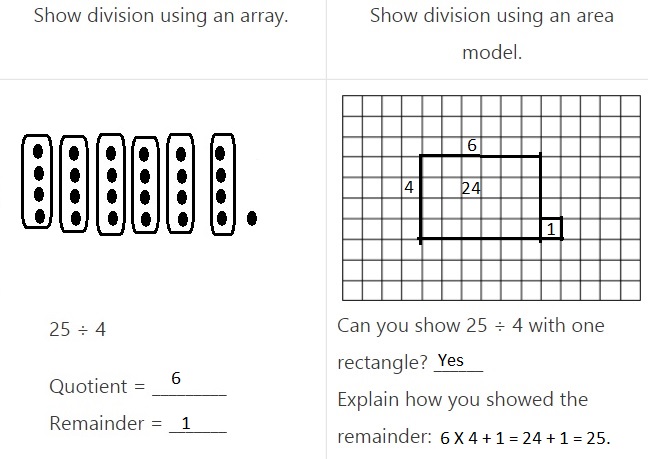
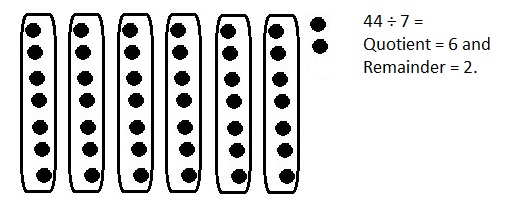
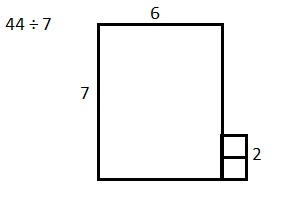
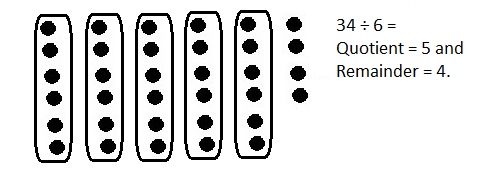

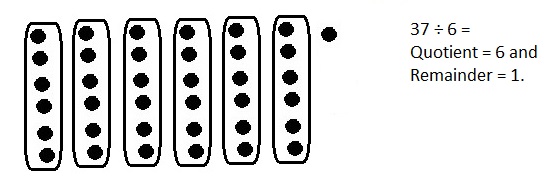
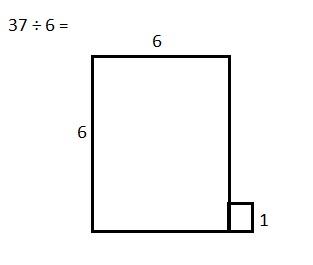
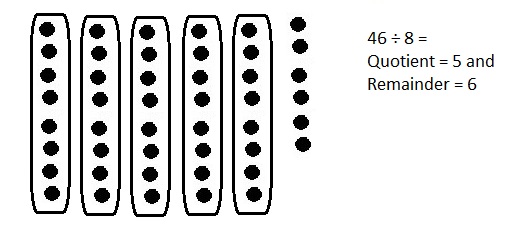









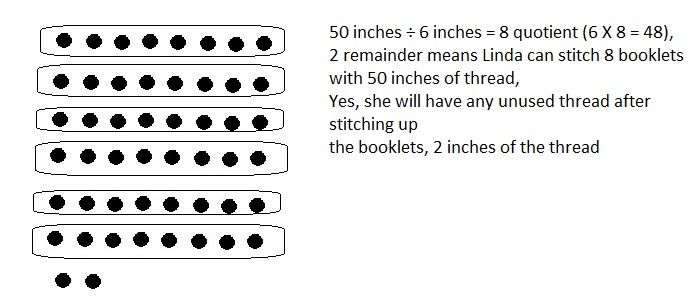
 Explanation:
Explanation:


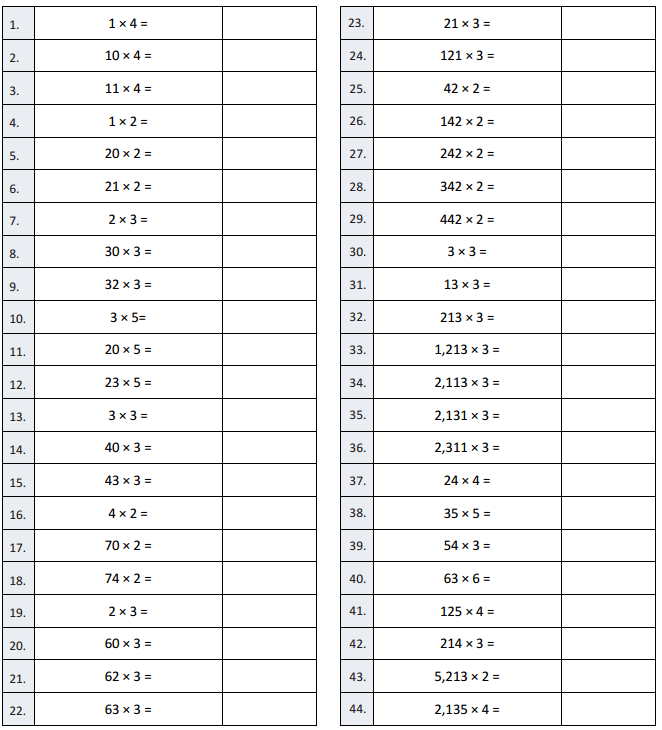
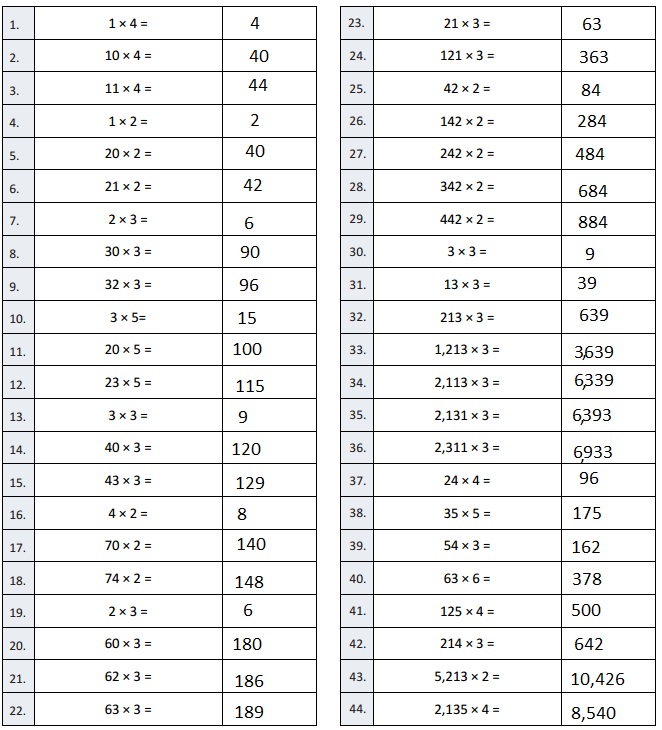
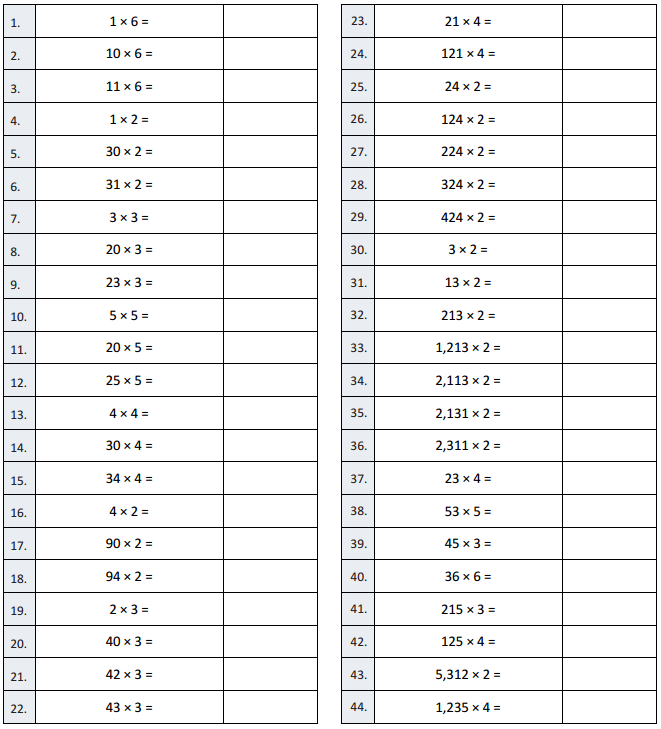
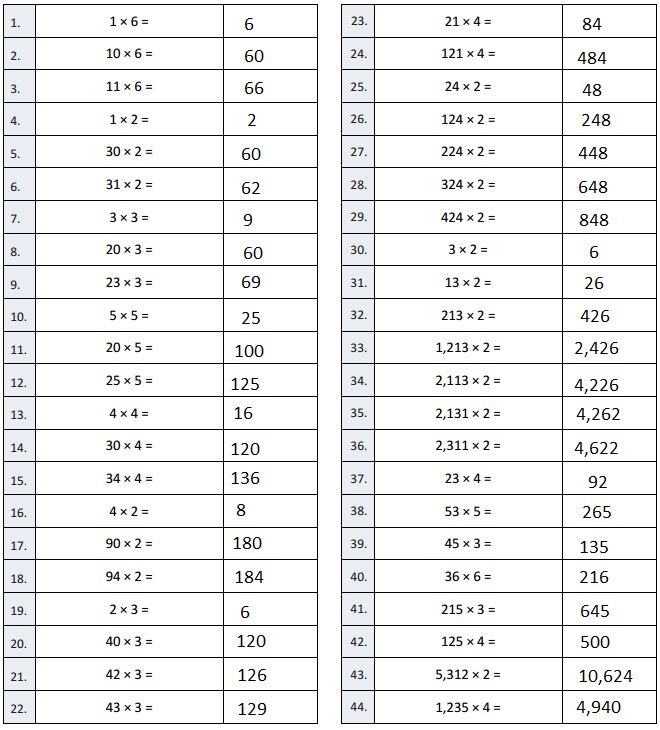
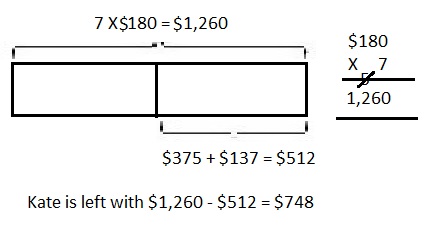

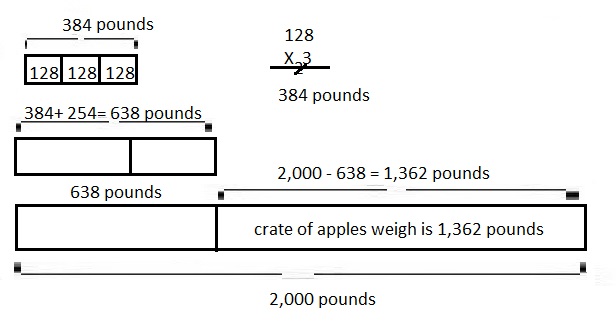
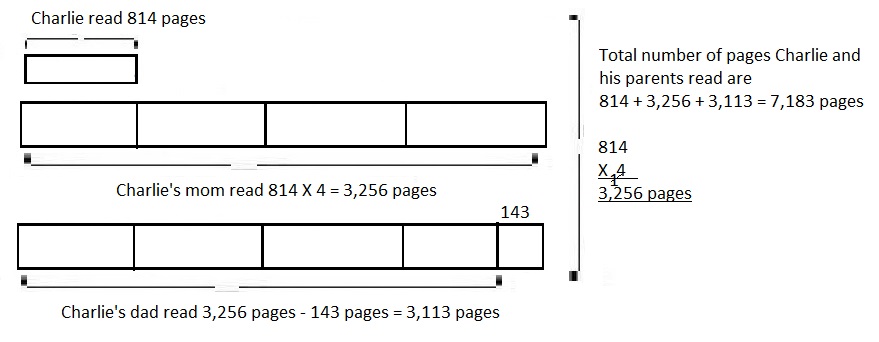



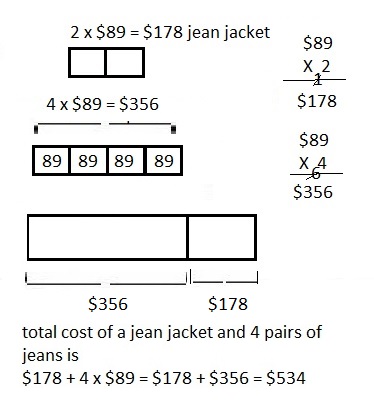
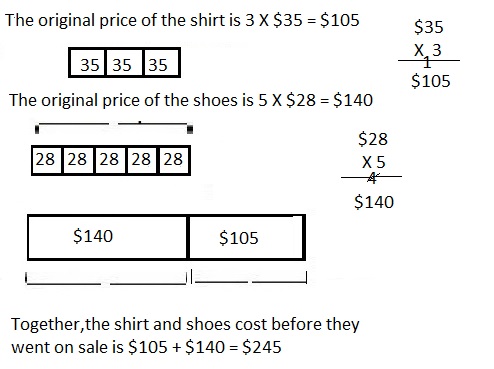

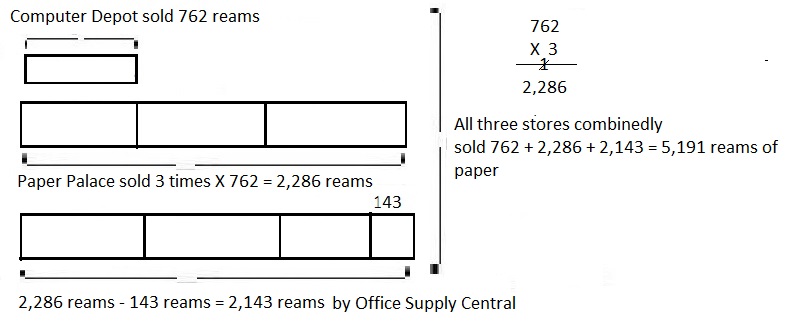

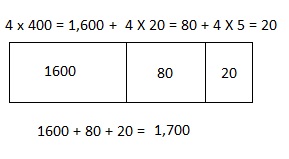
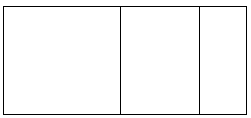
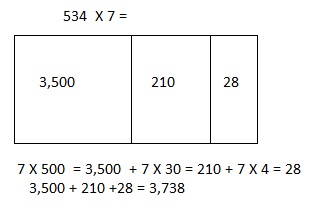

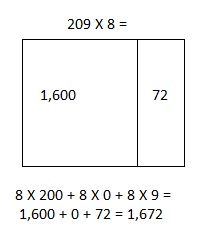
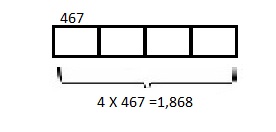

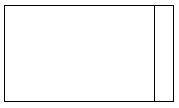
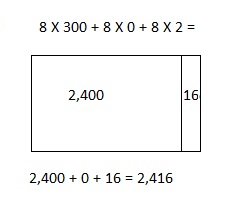

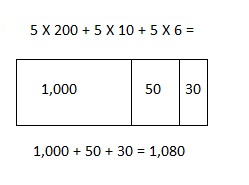
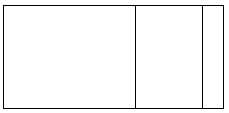
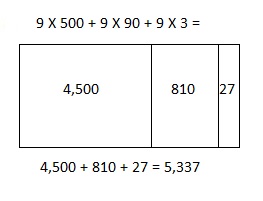
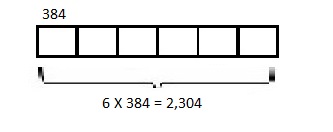


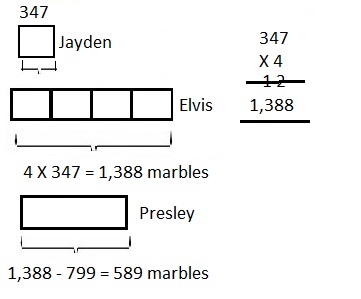
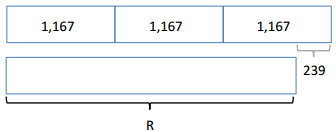
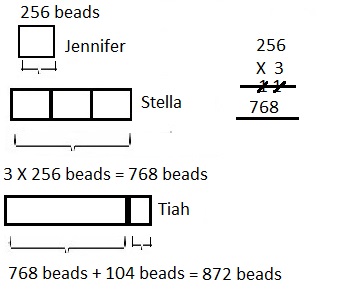


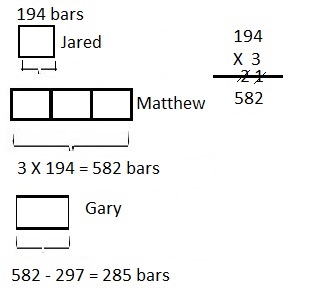

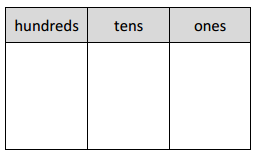
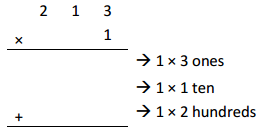
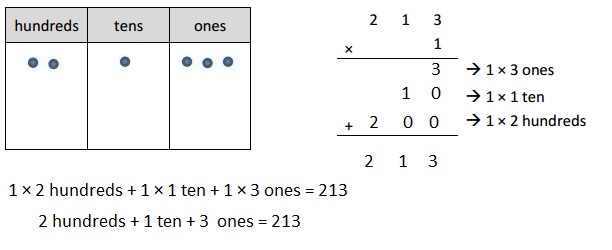
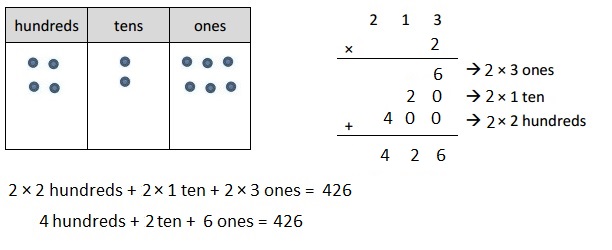
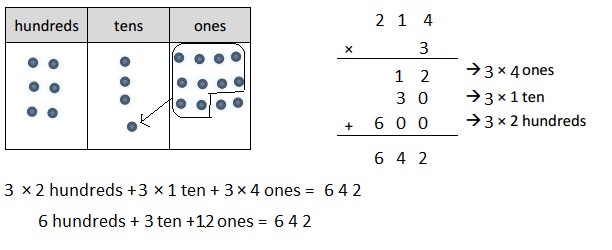
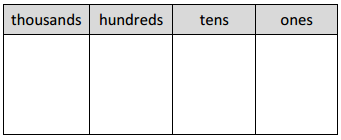
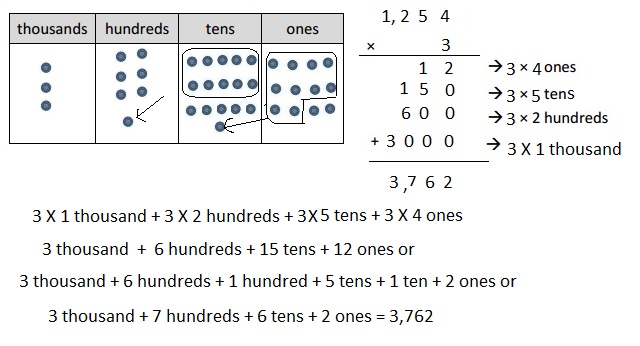
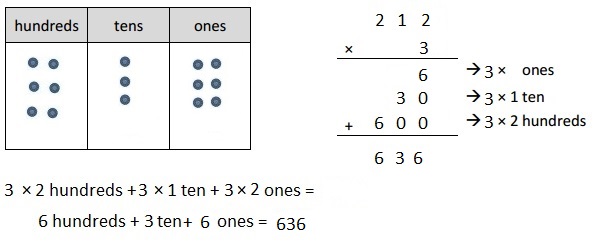
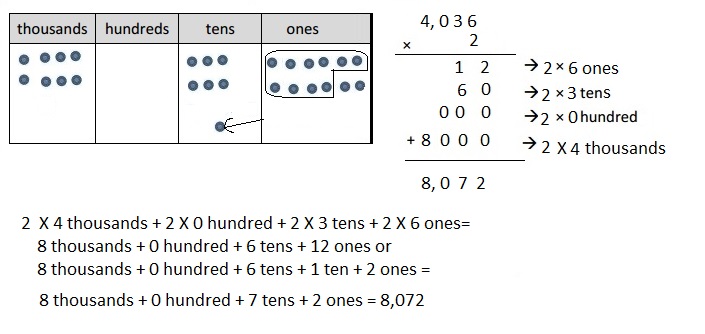
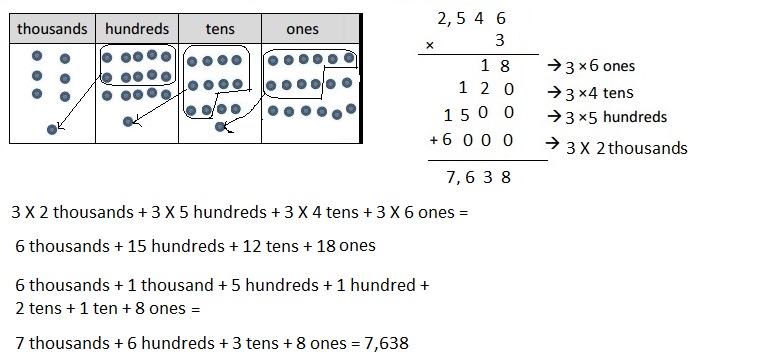
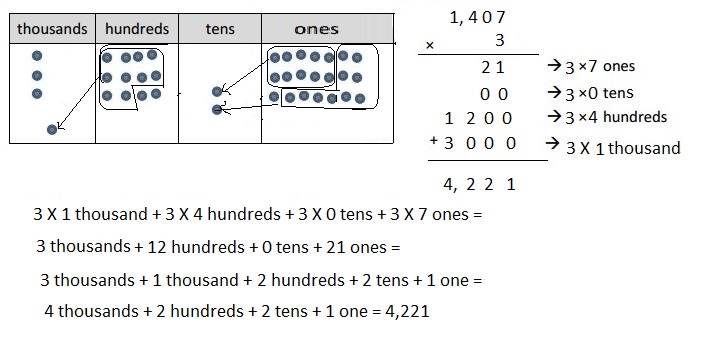 Explanation:
Explanation:
